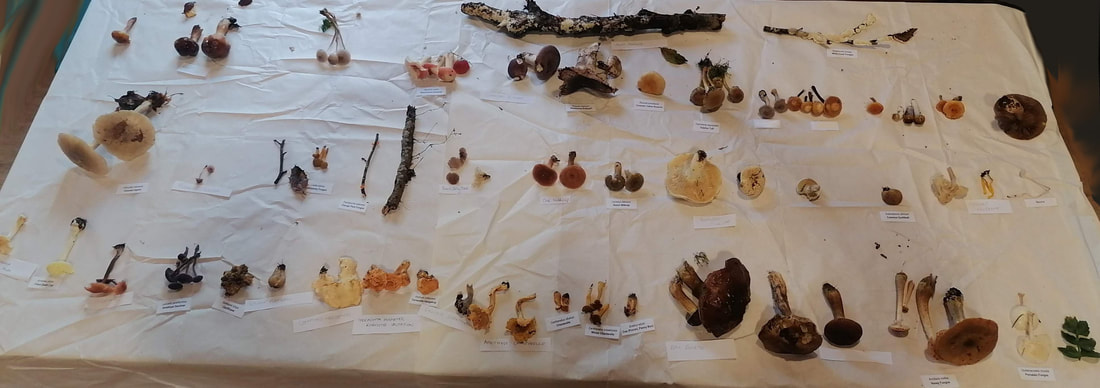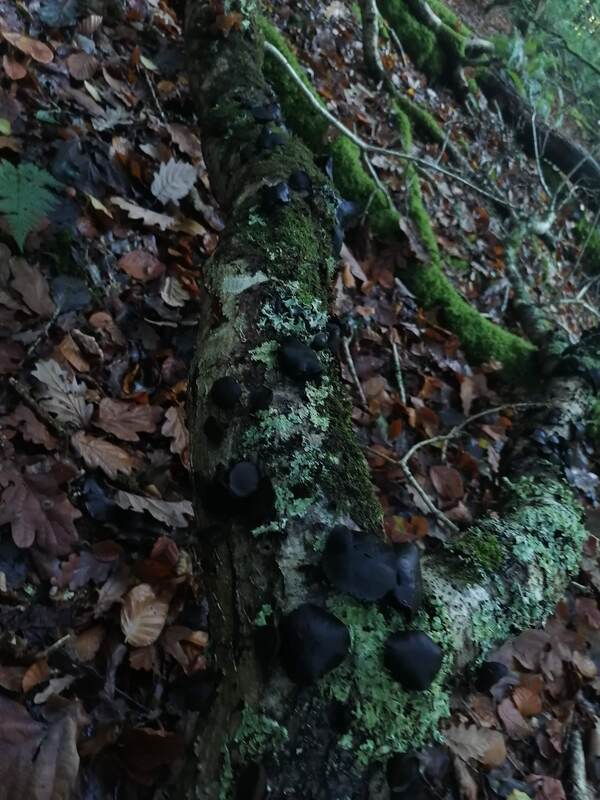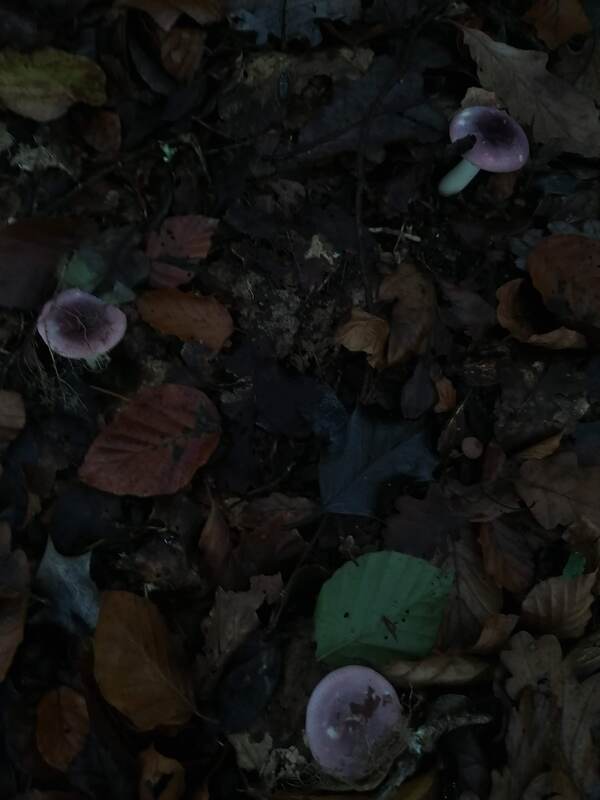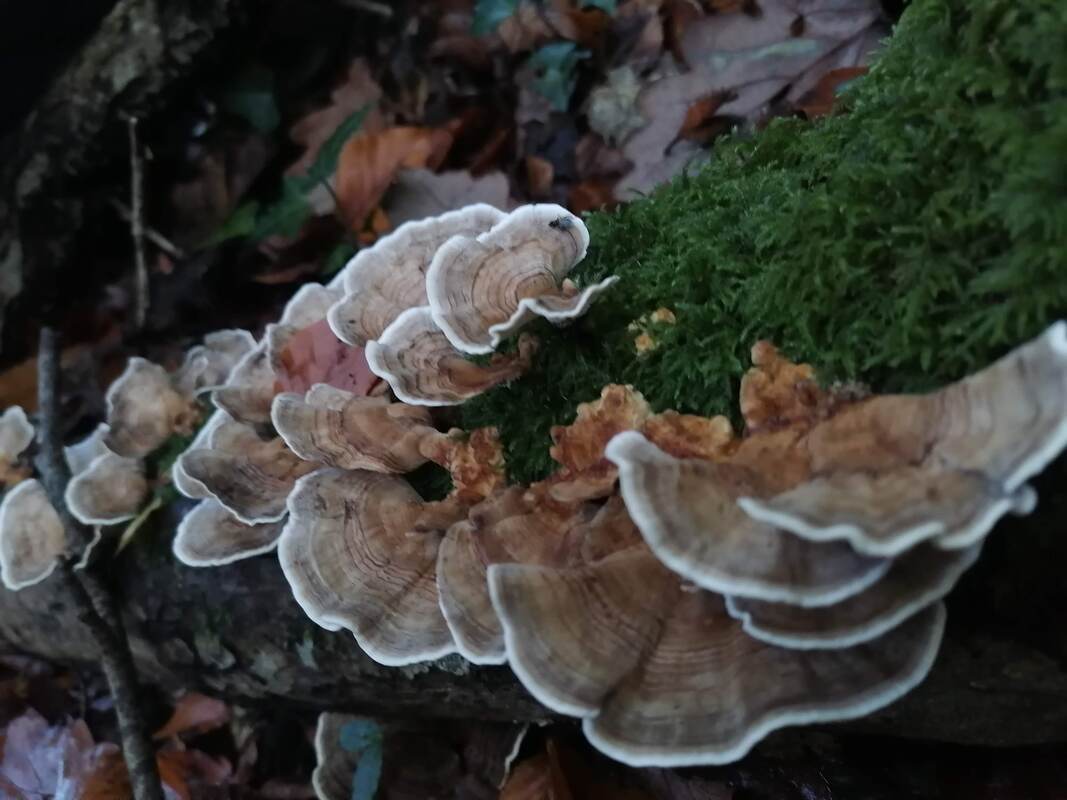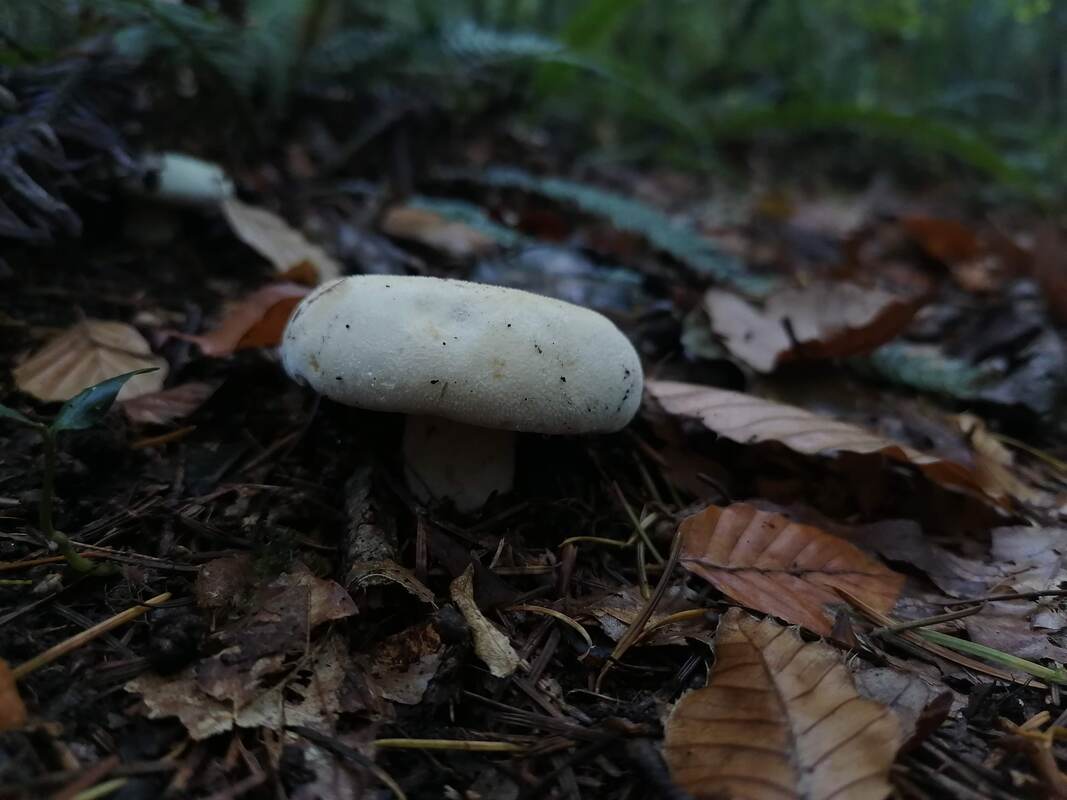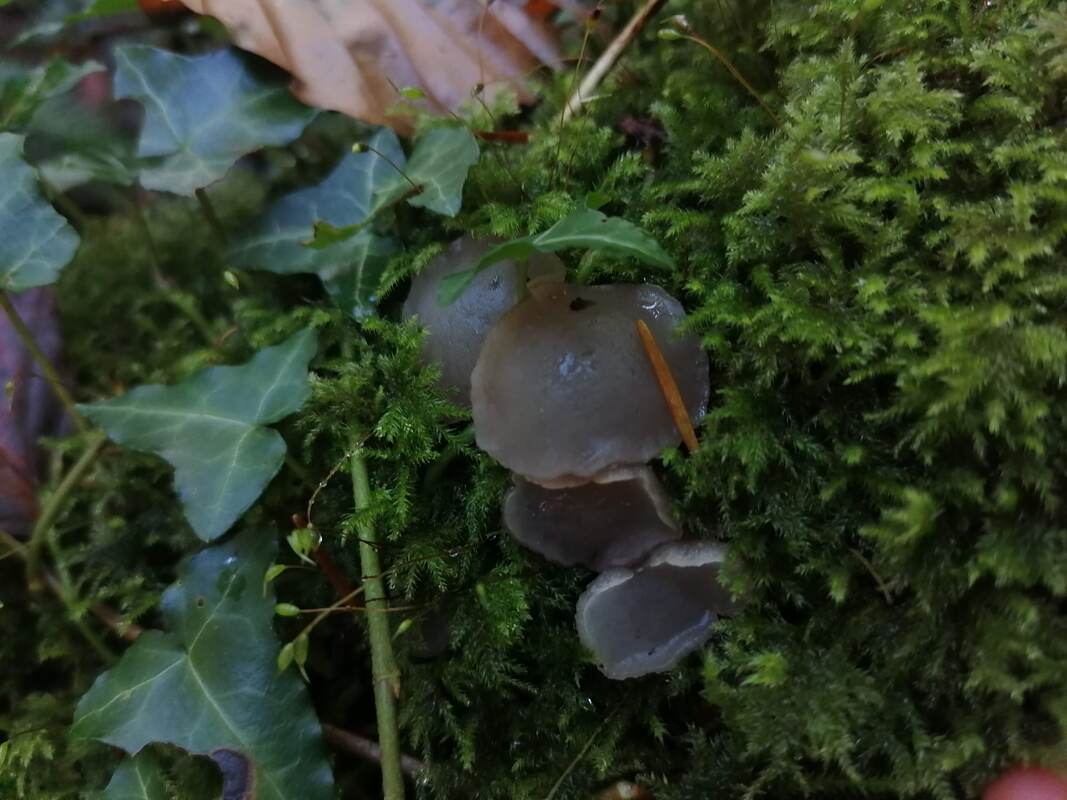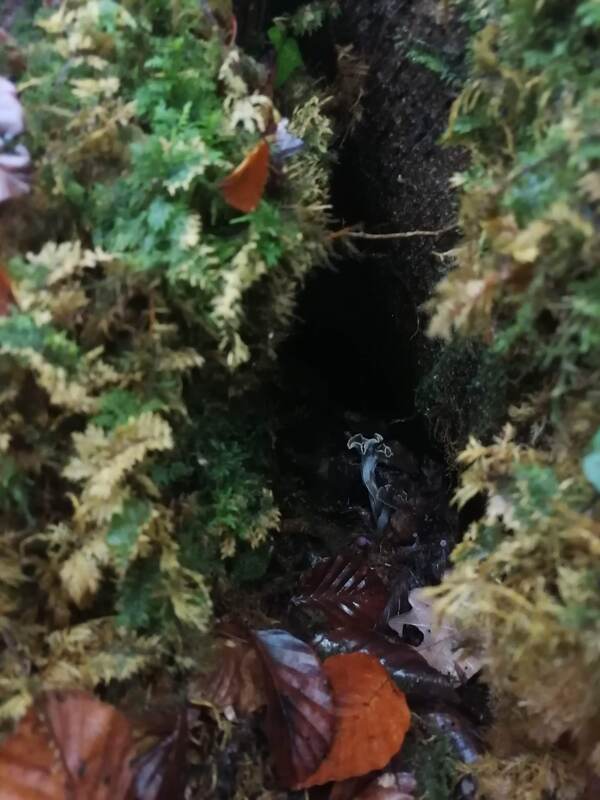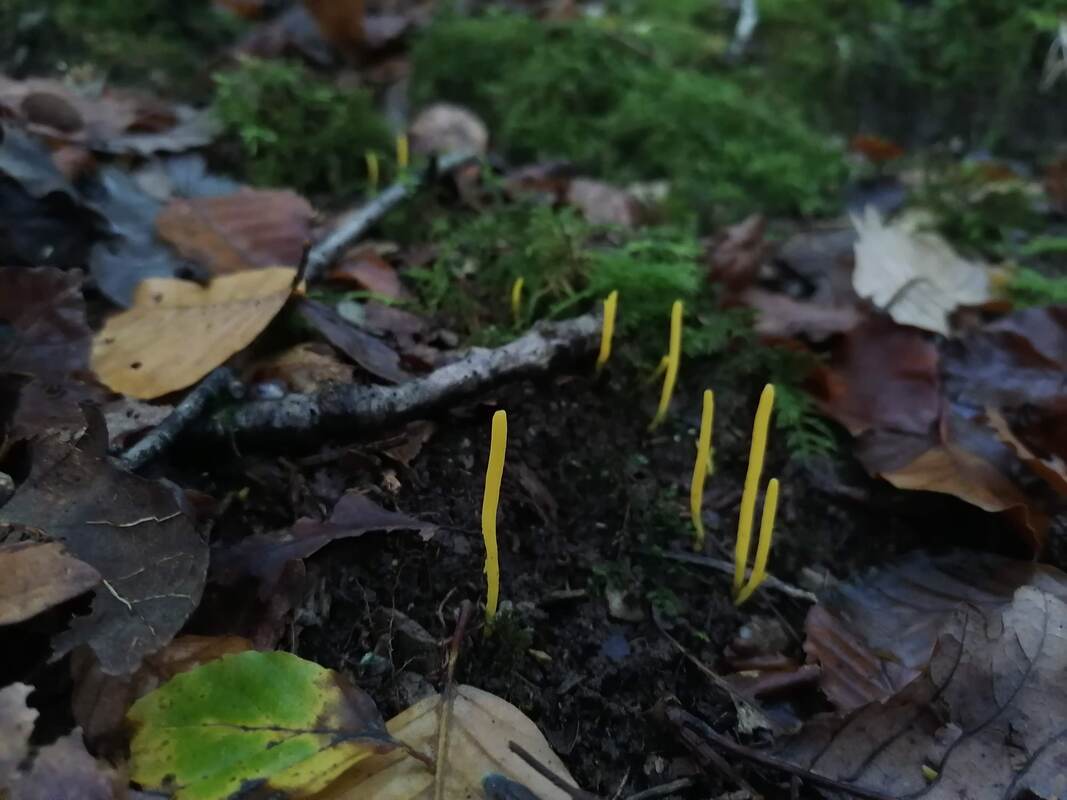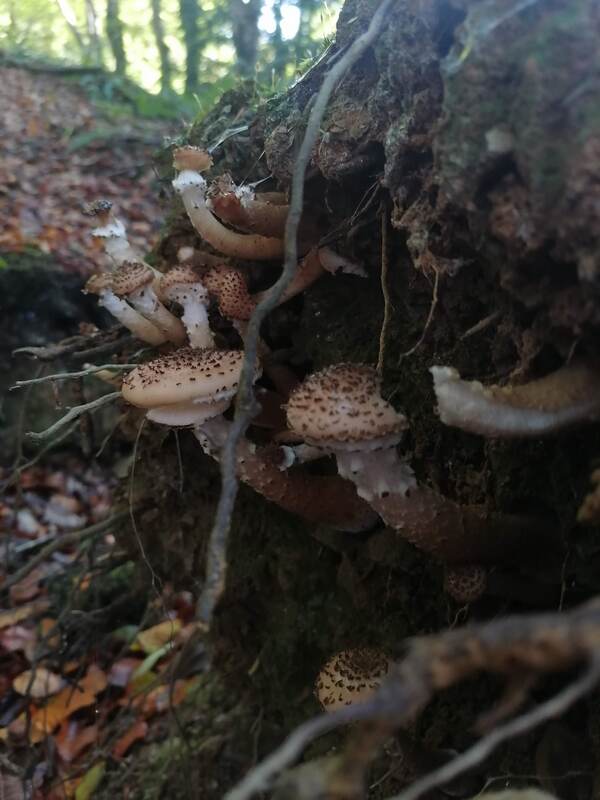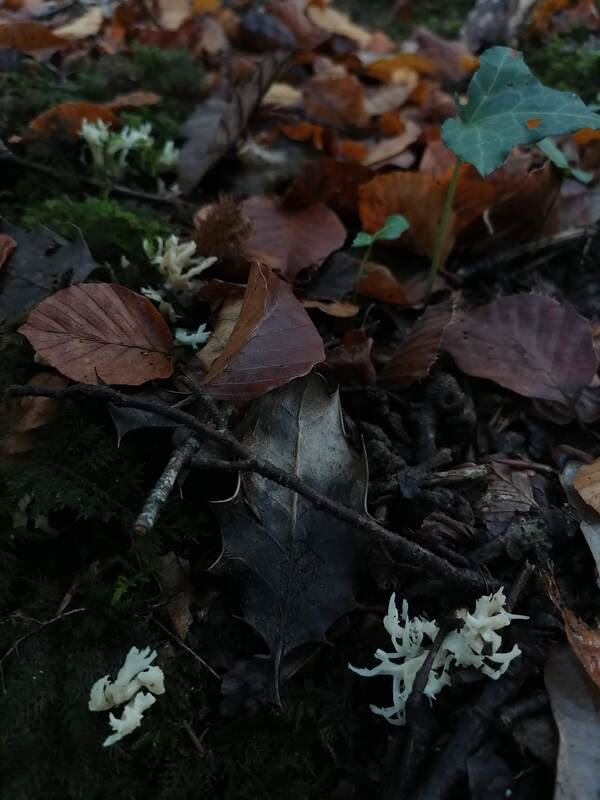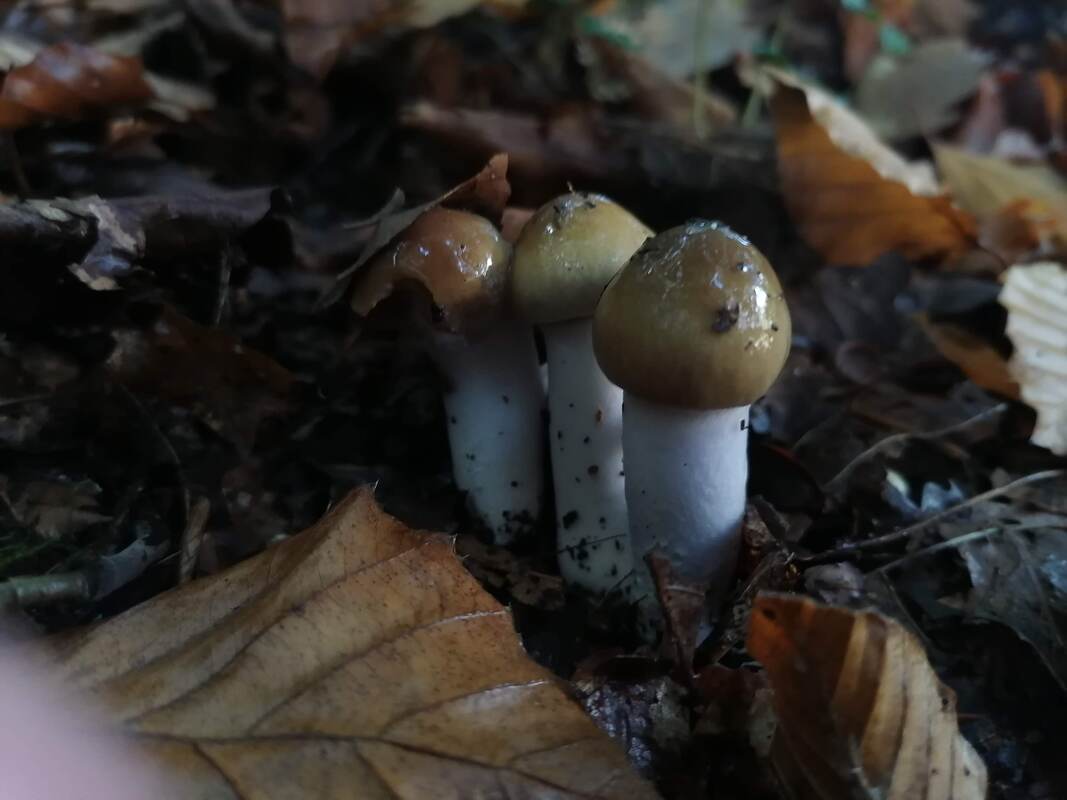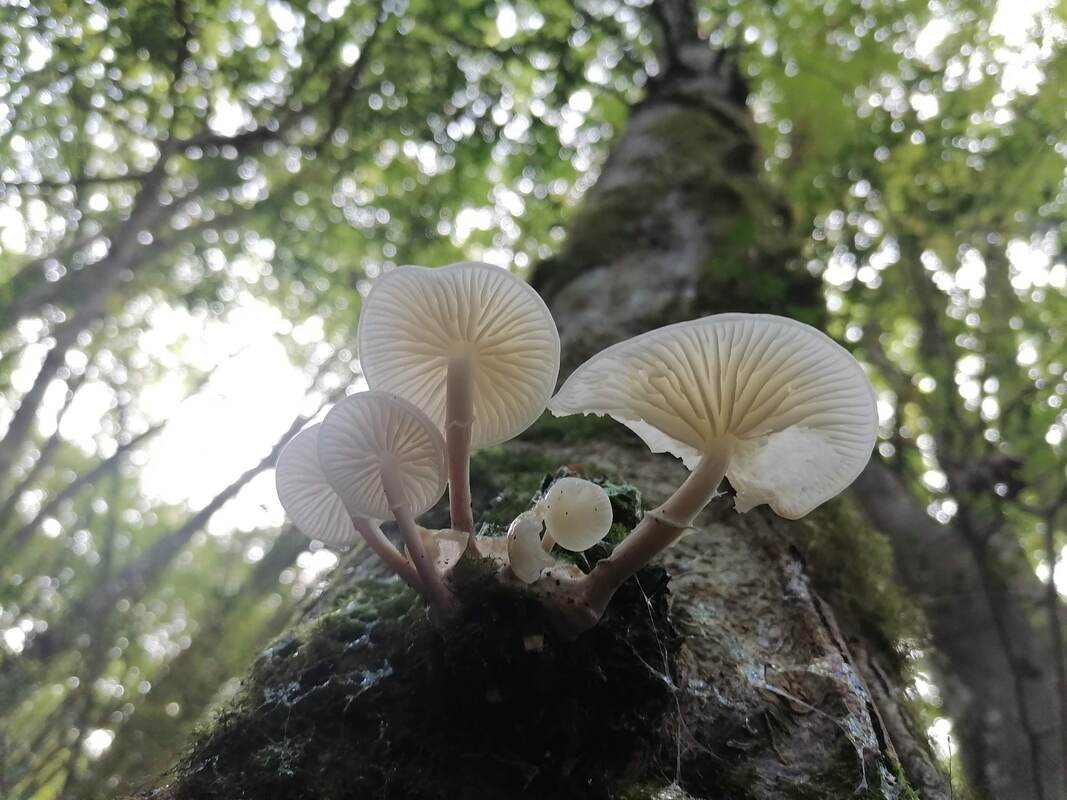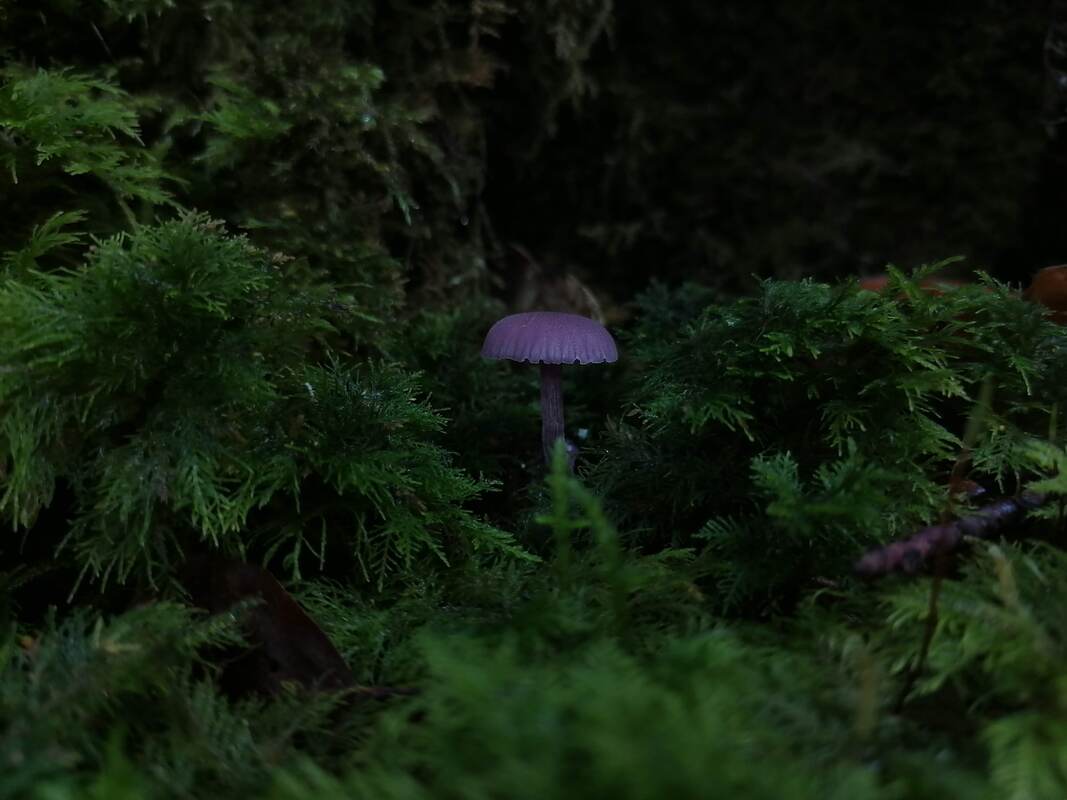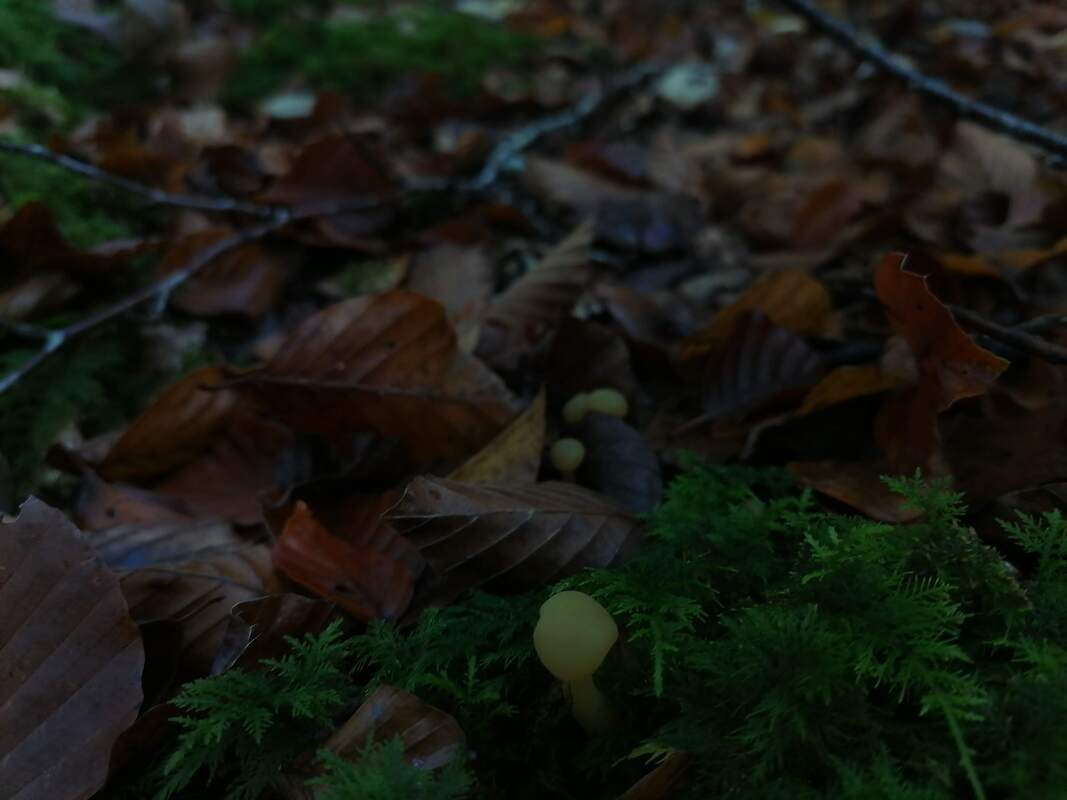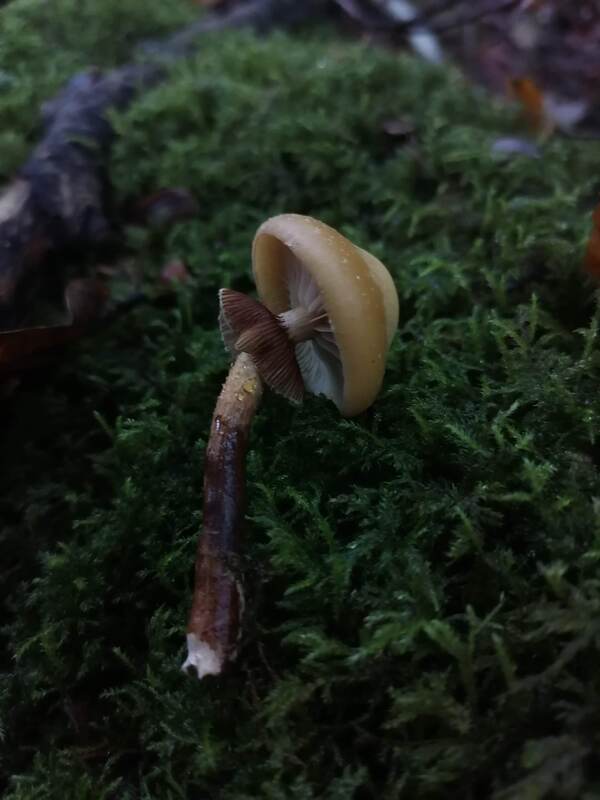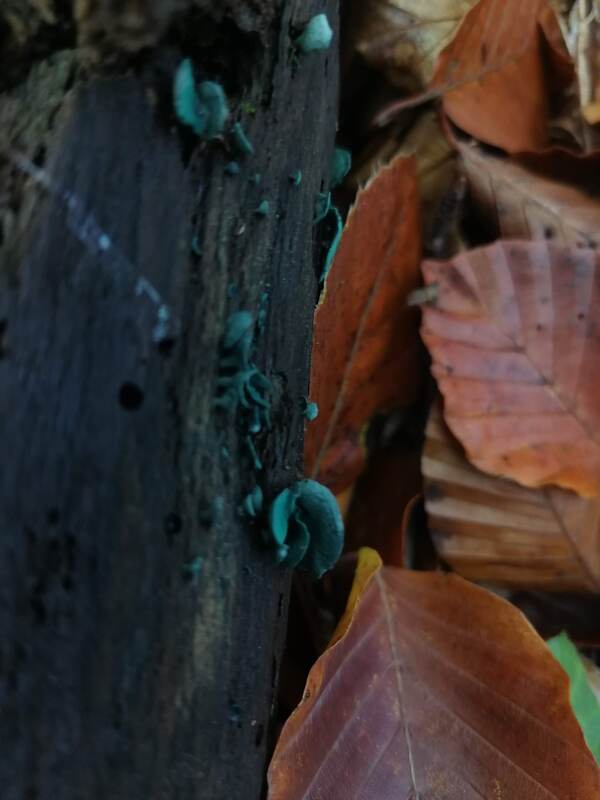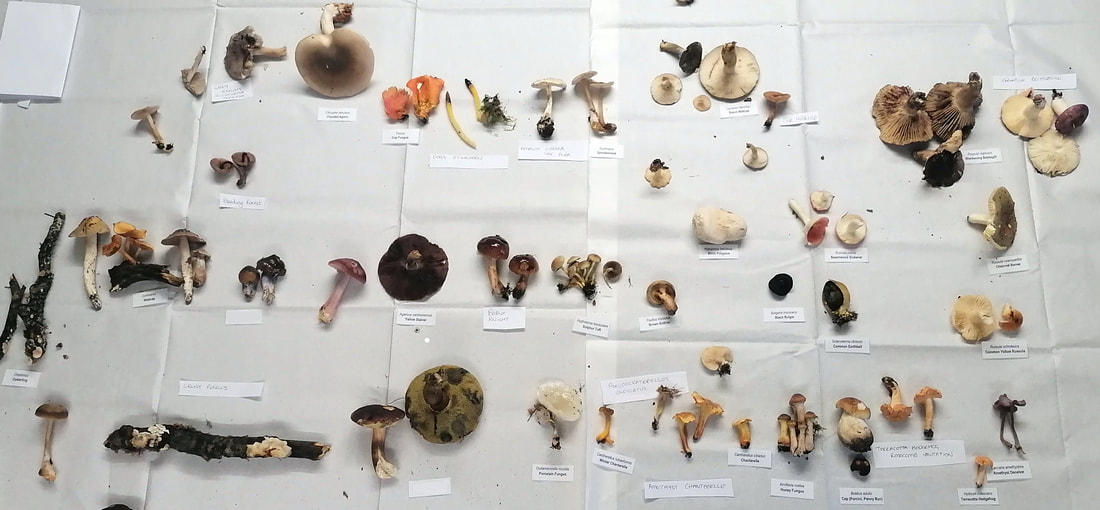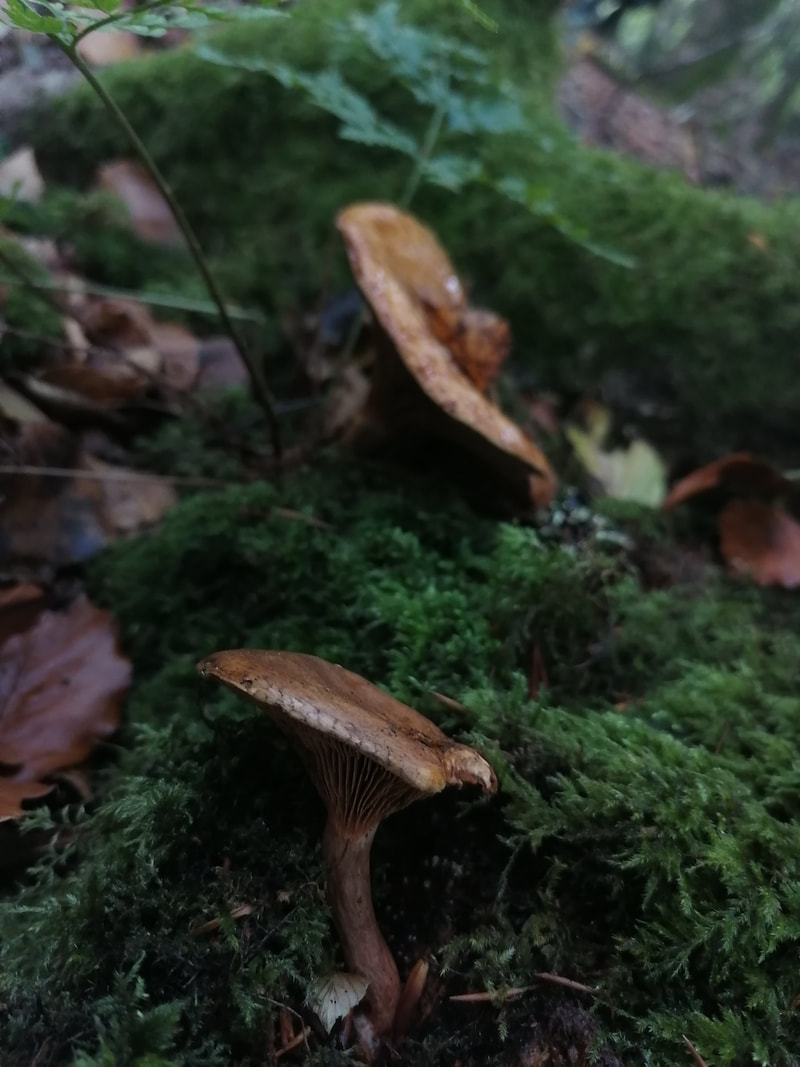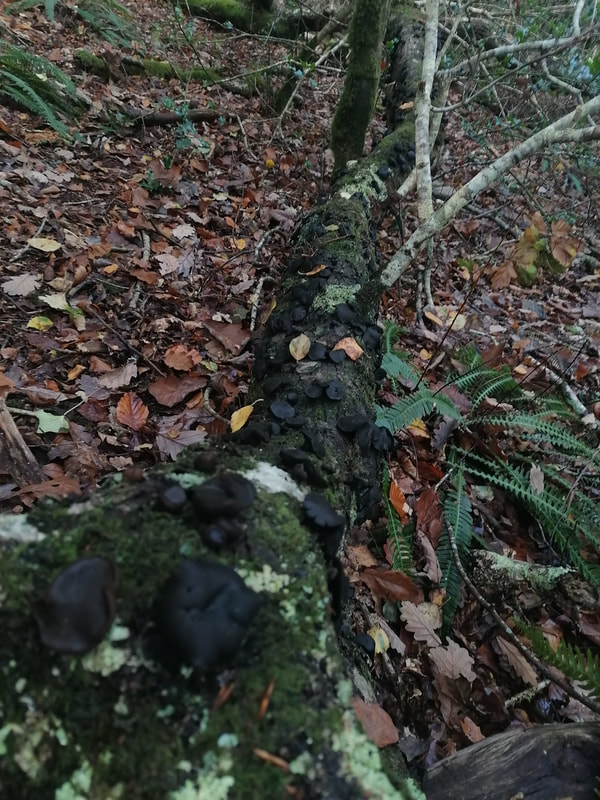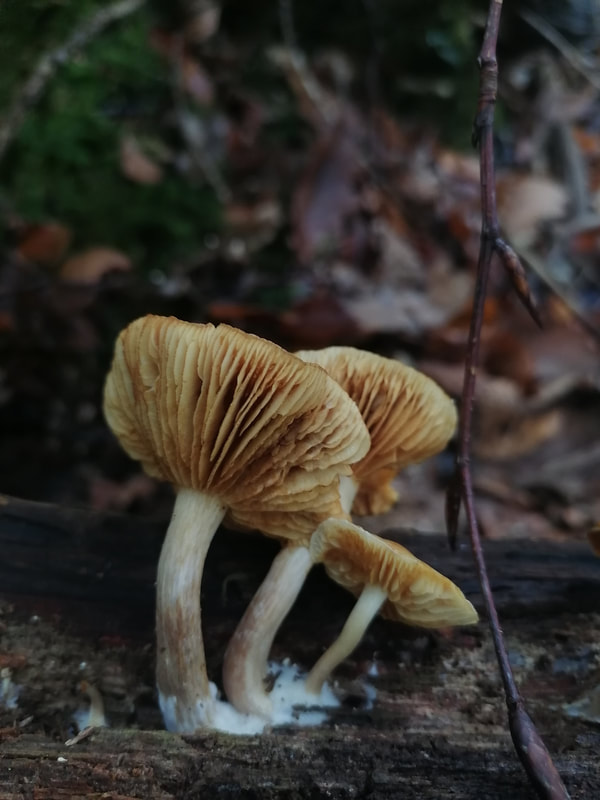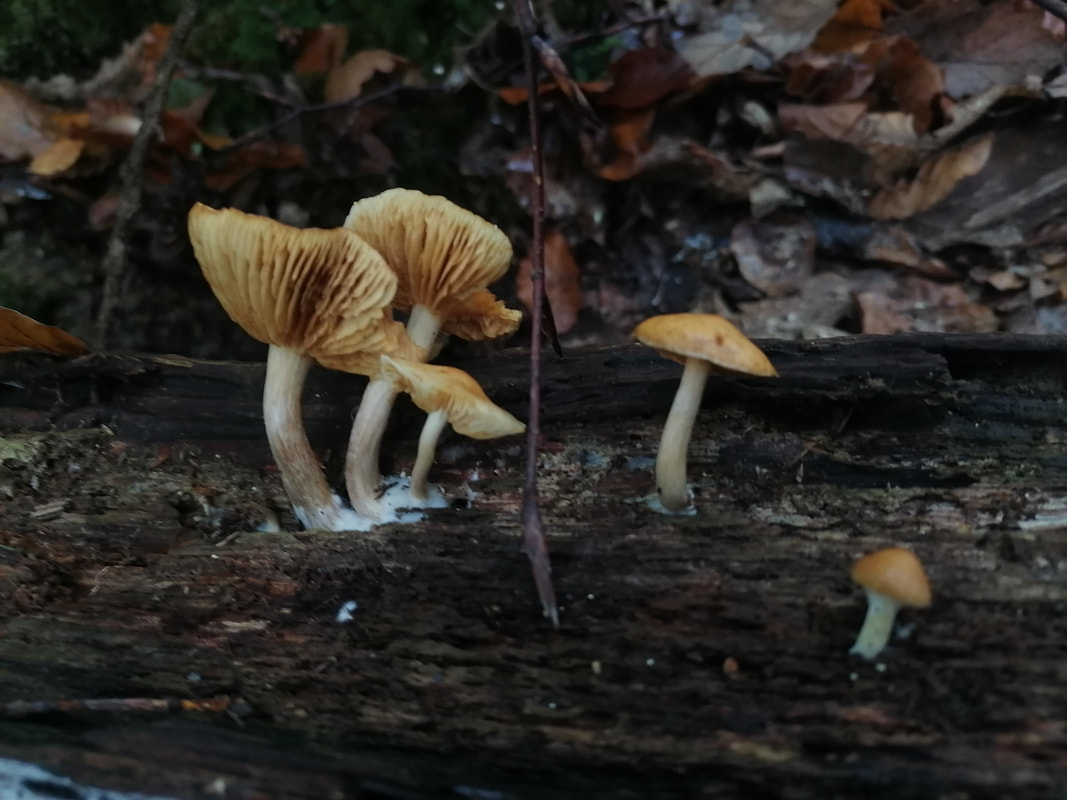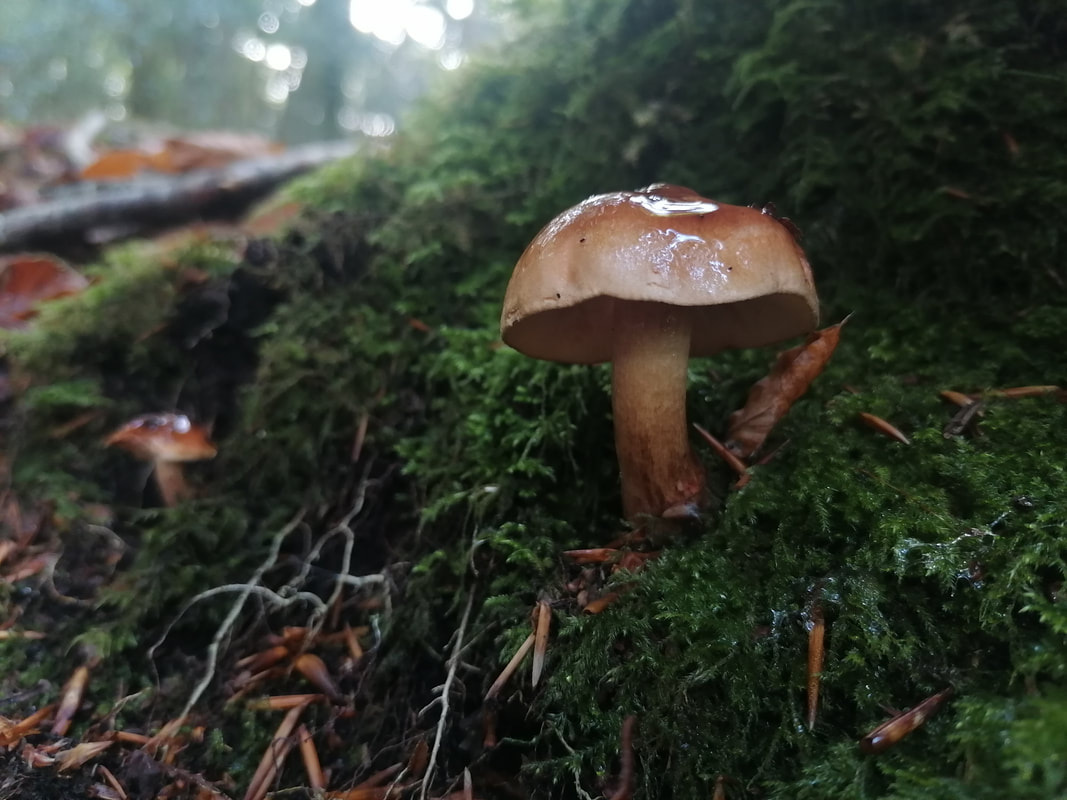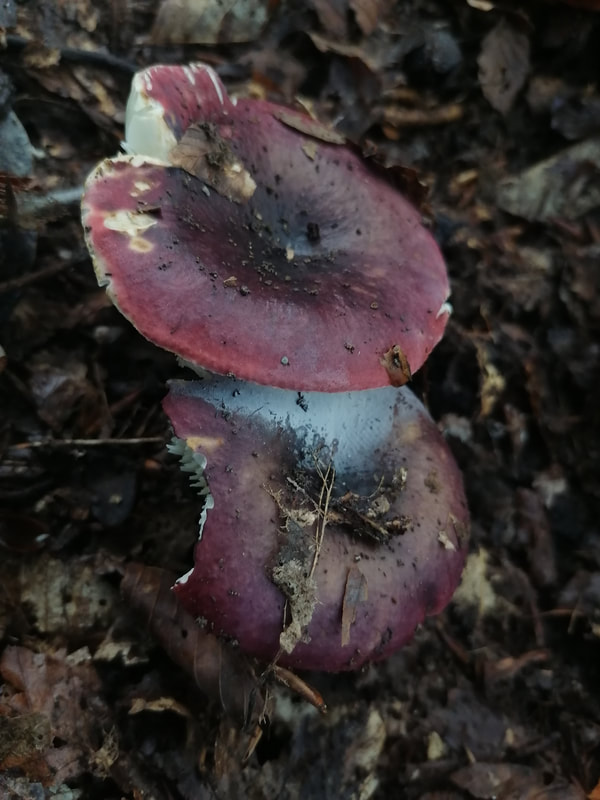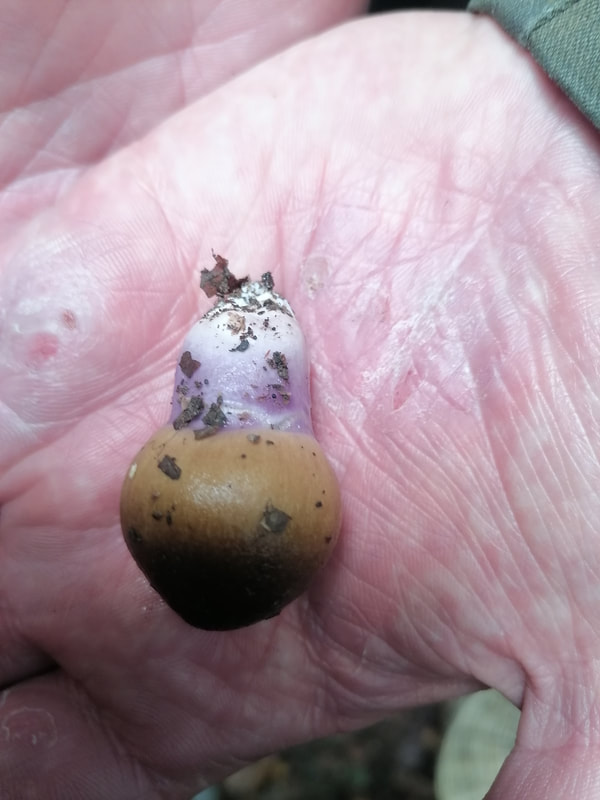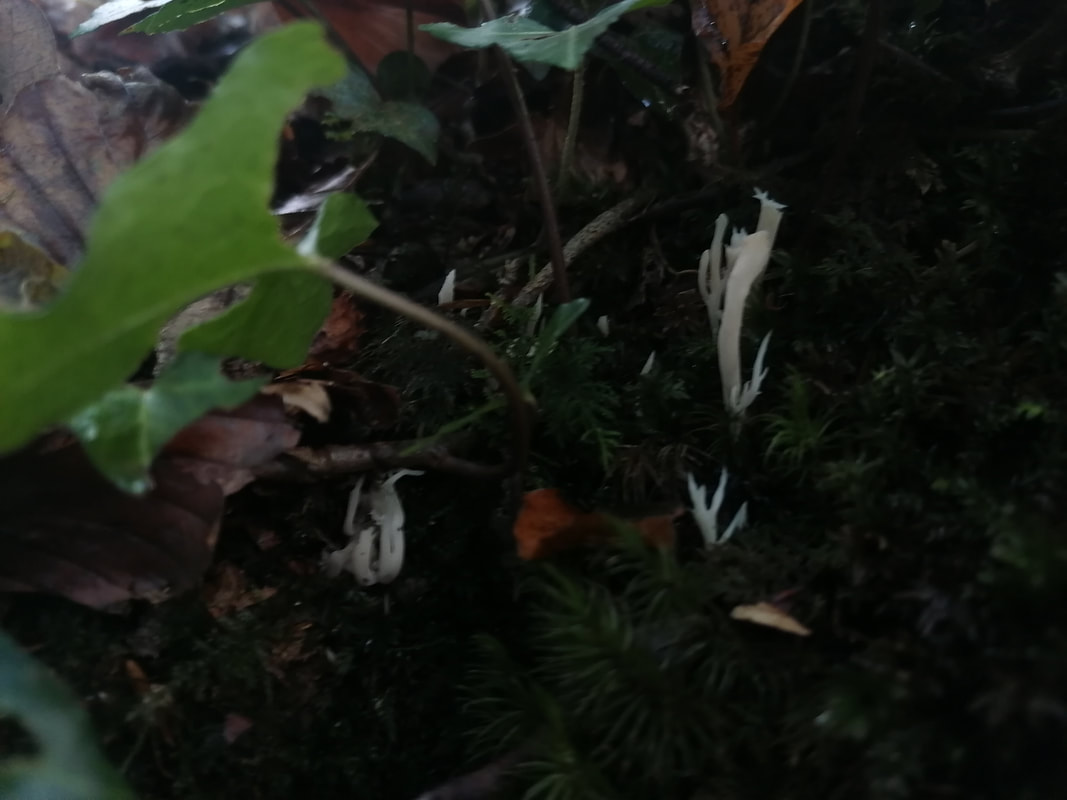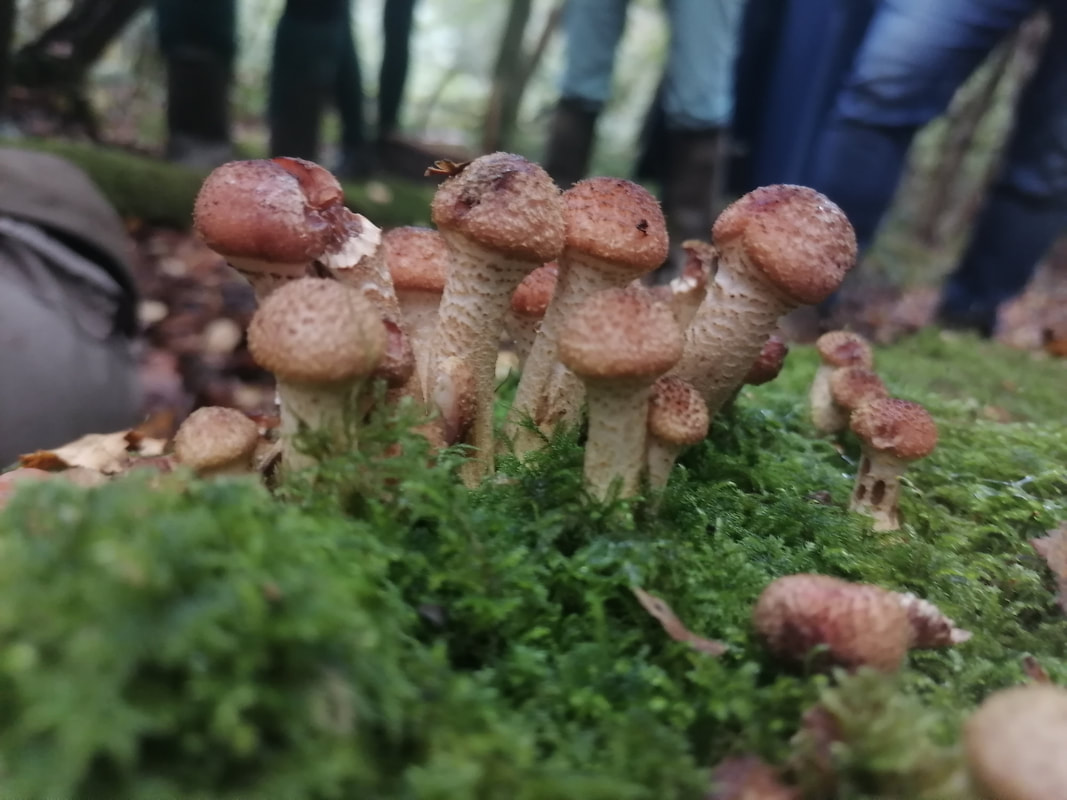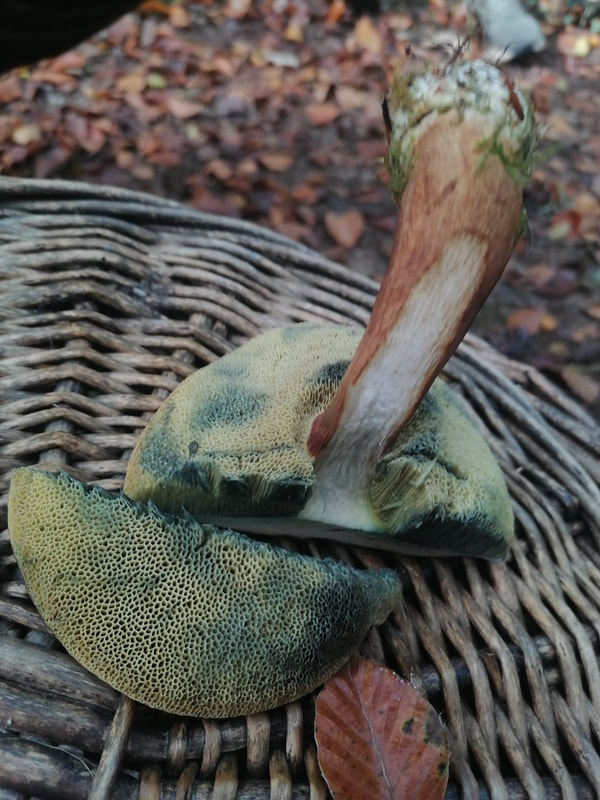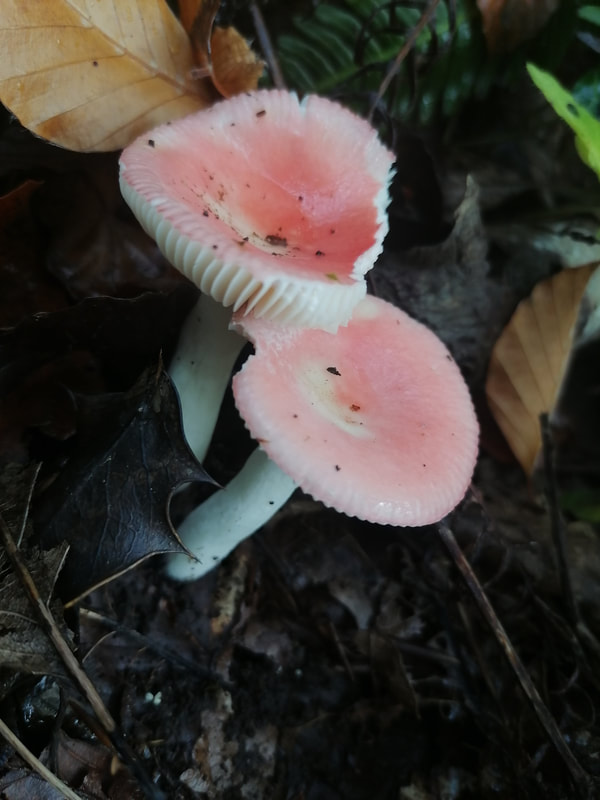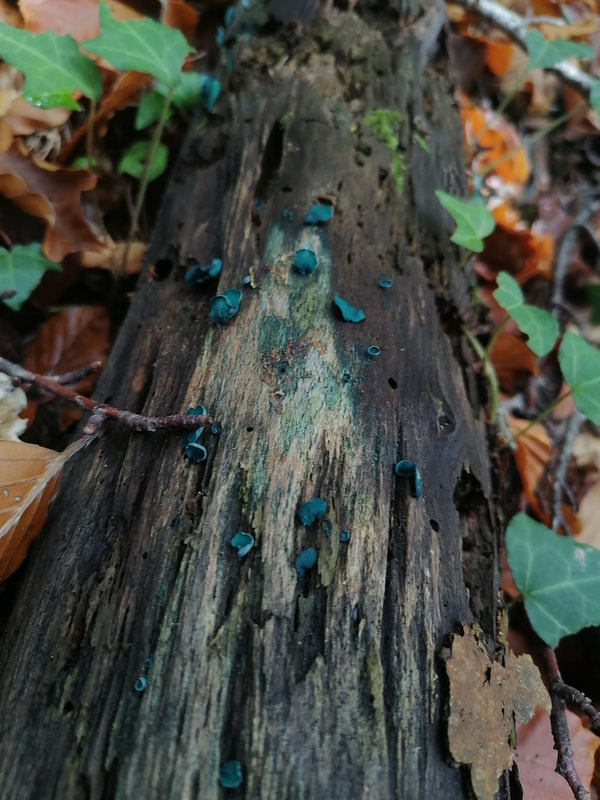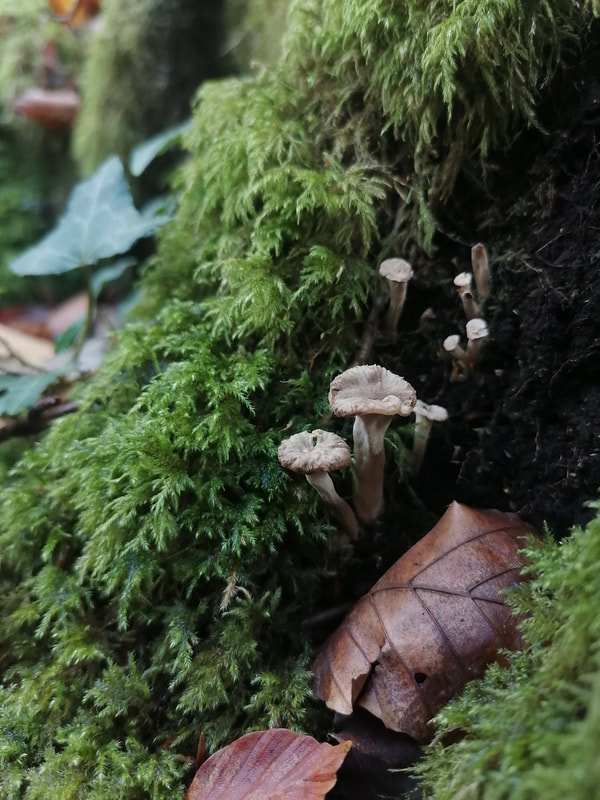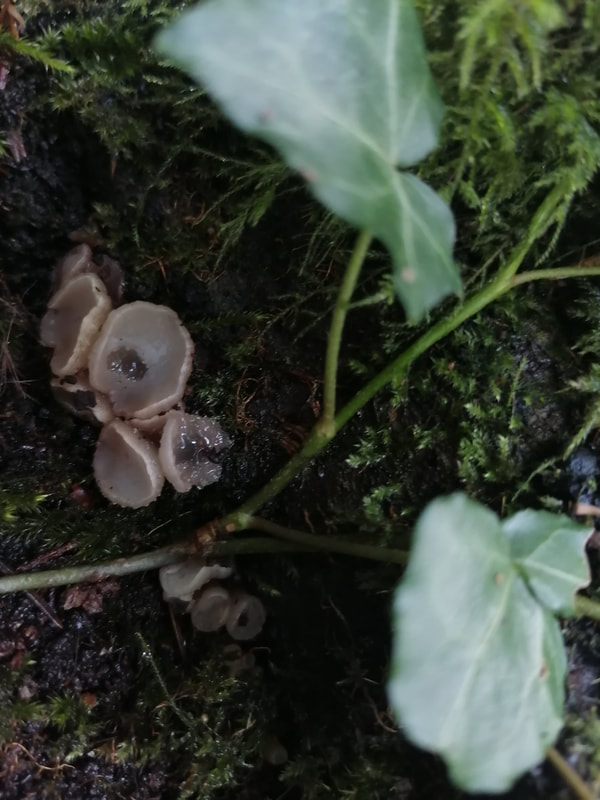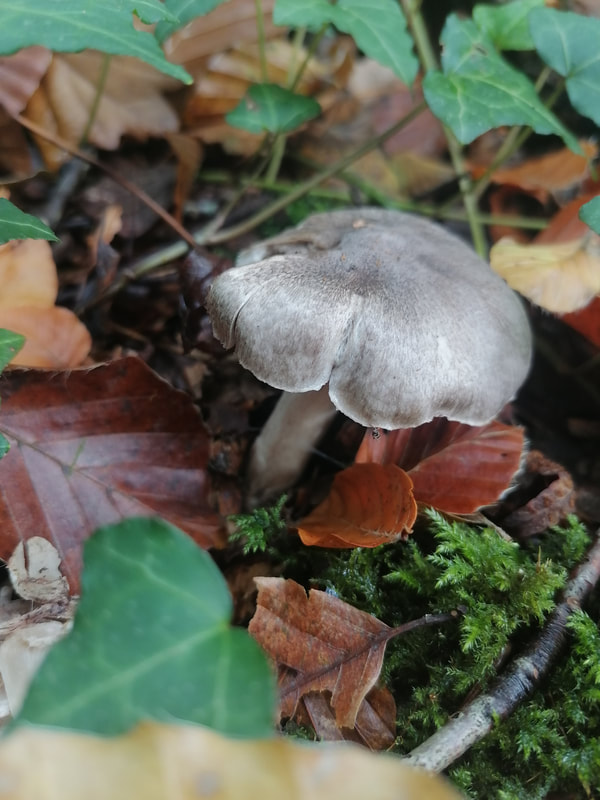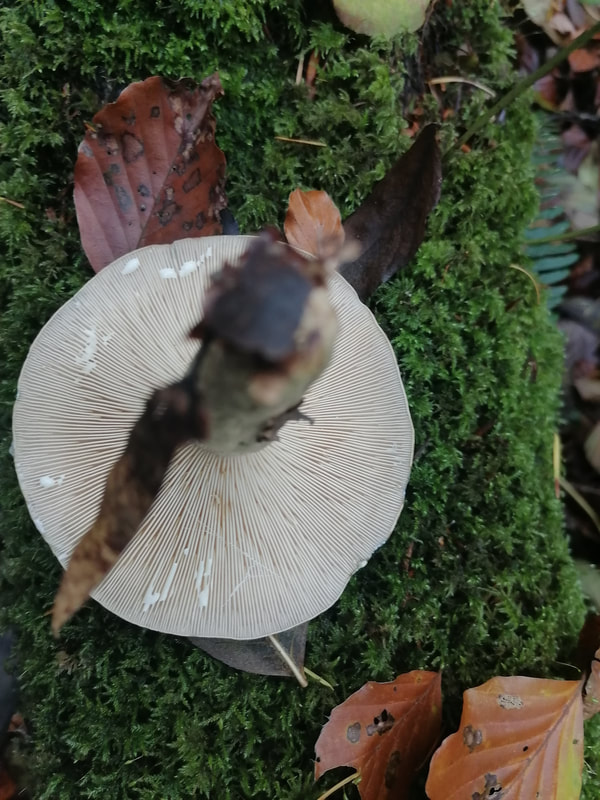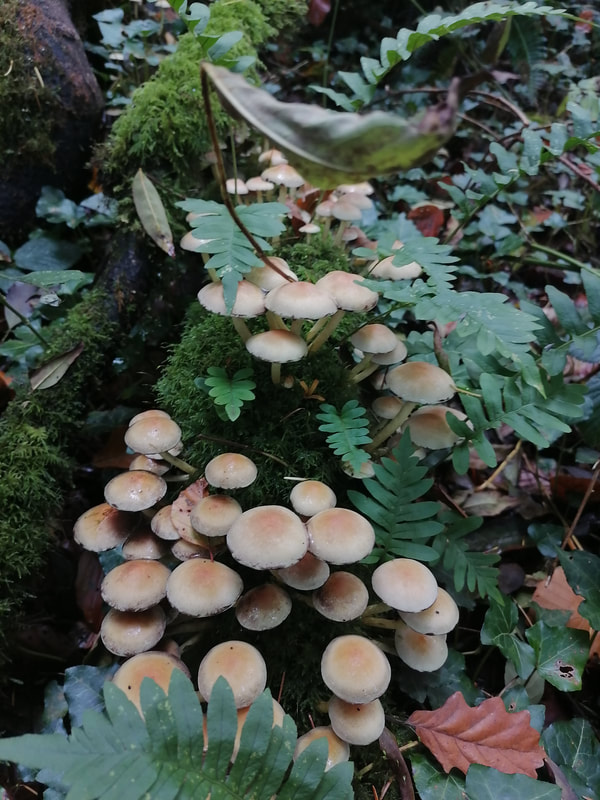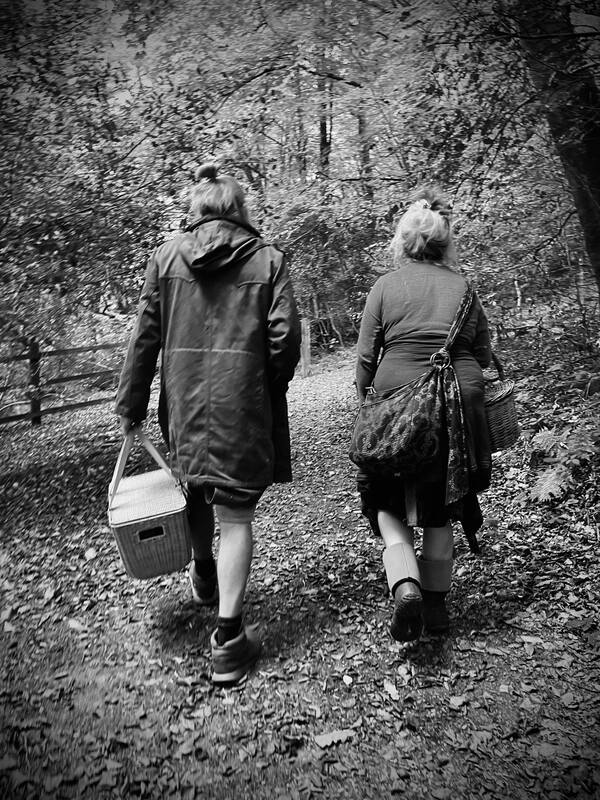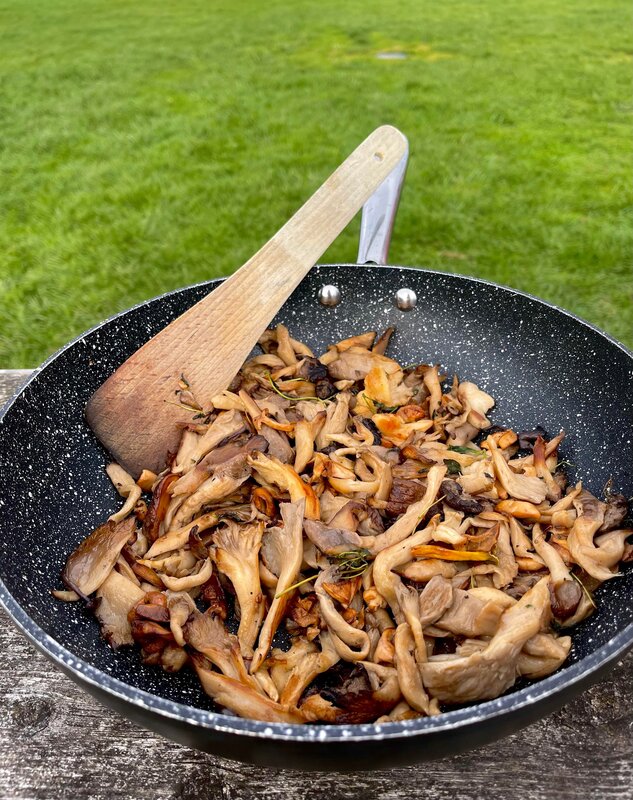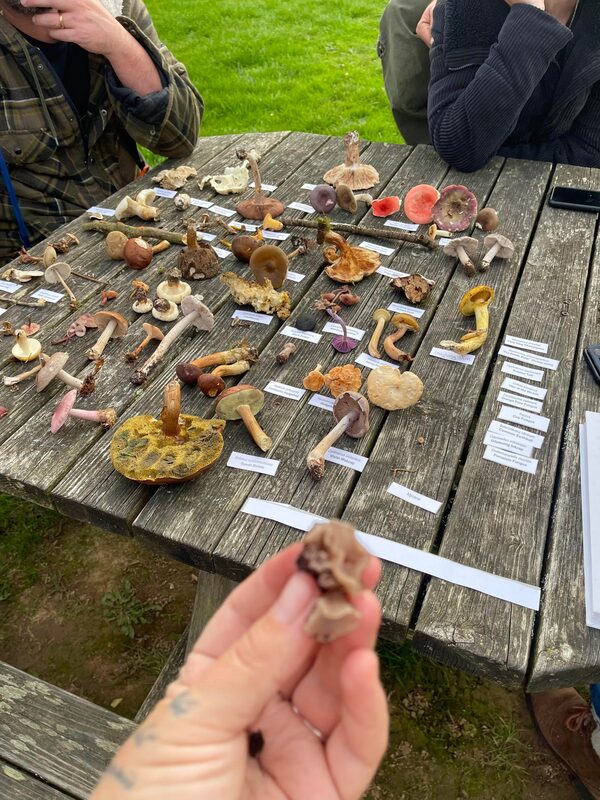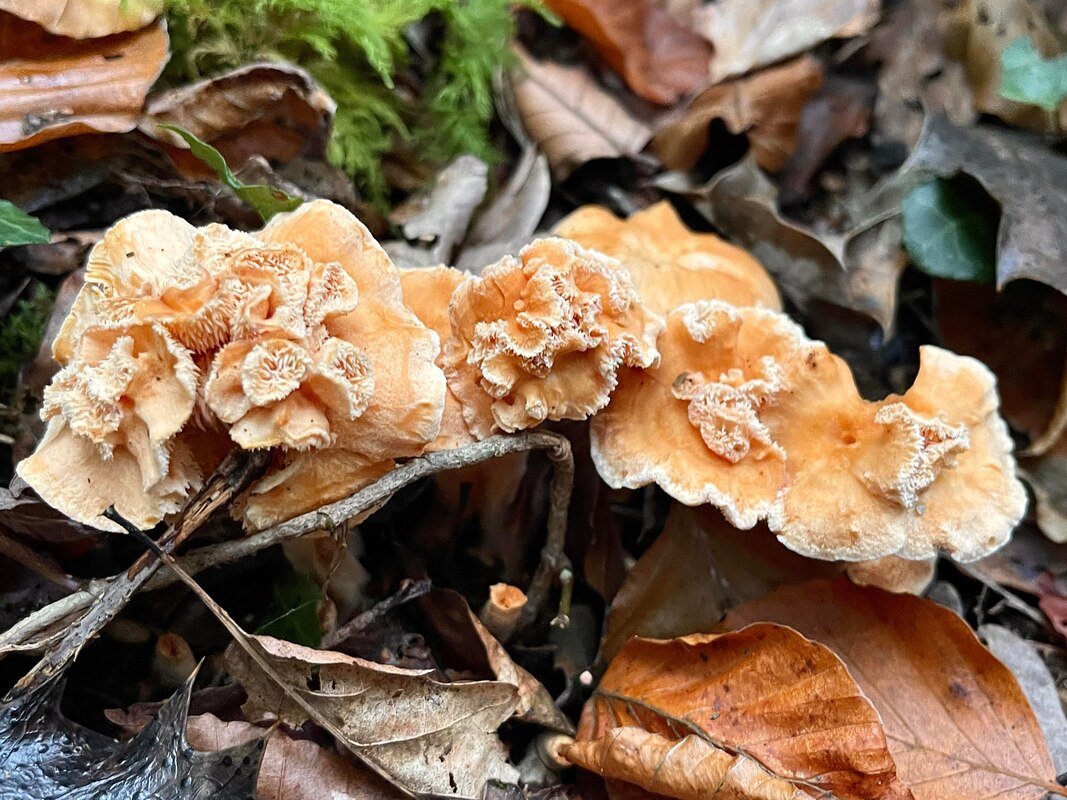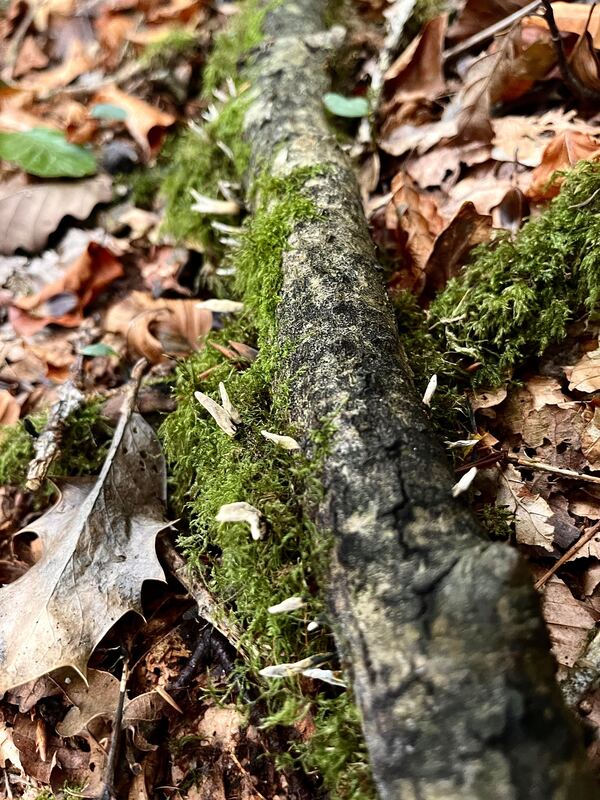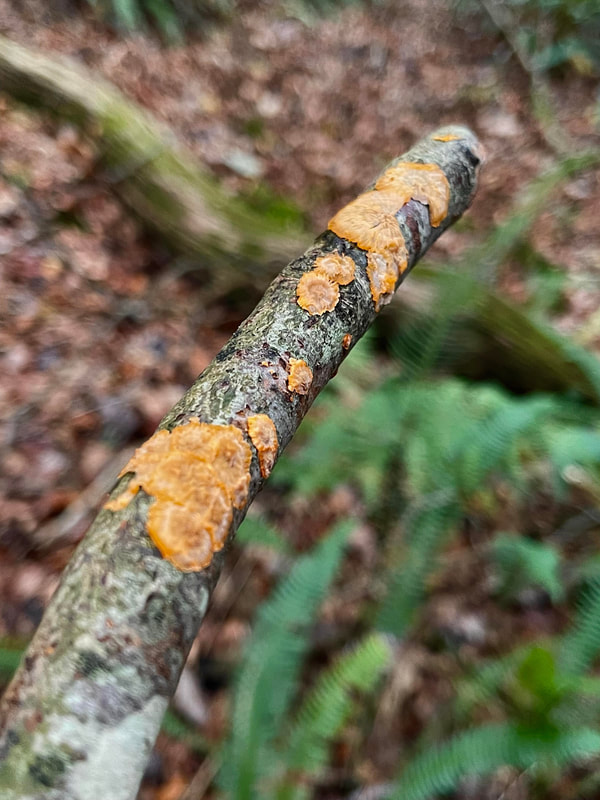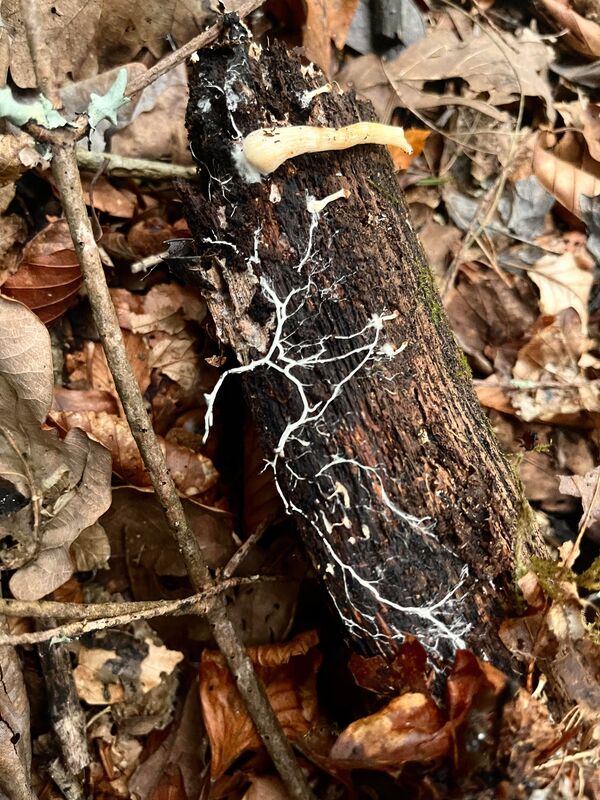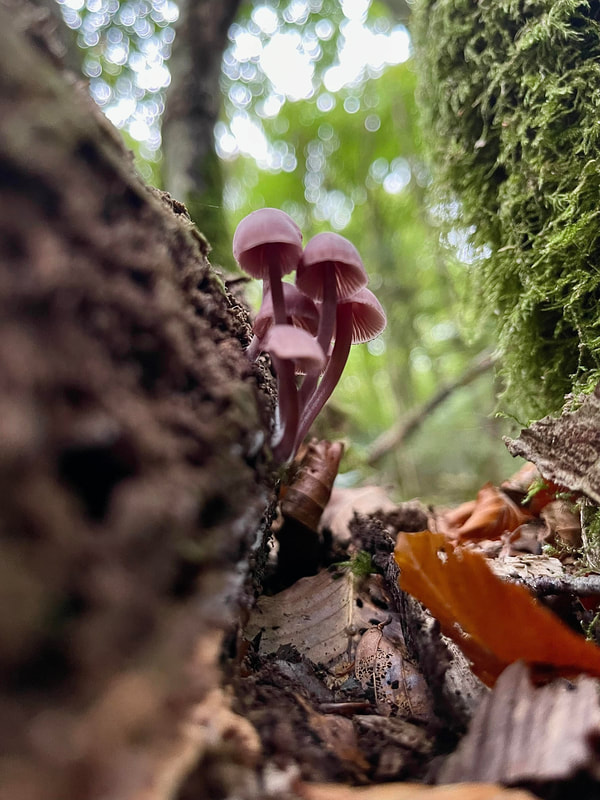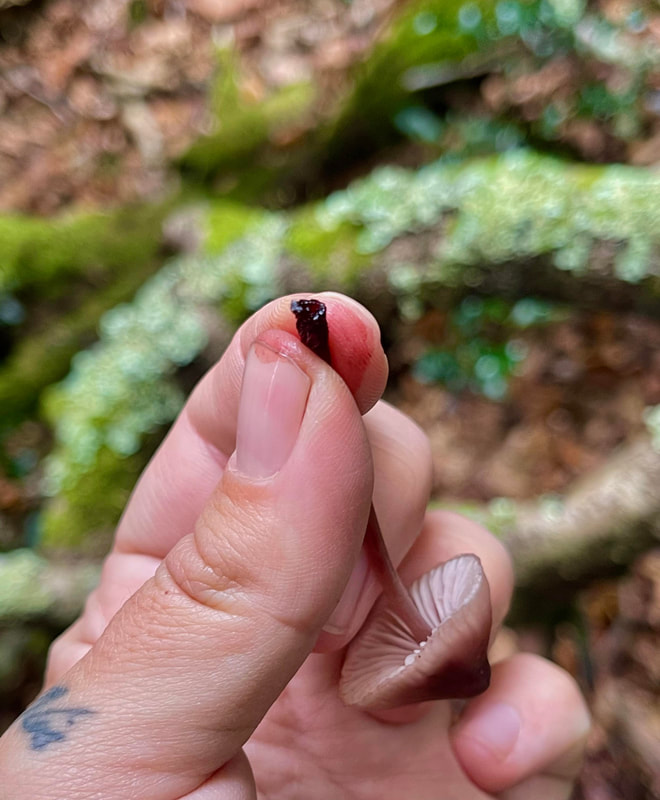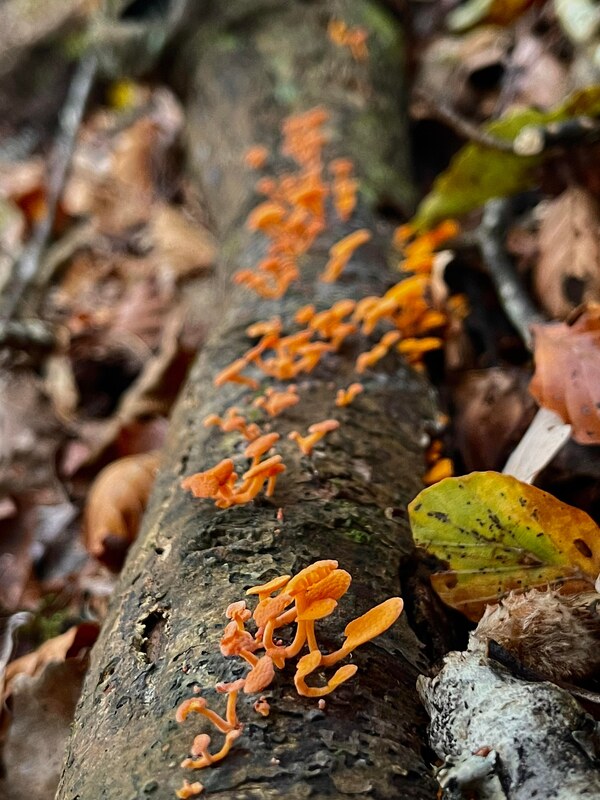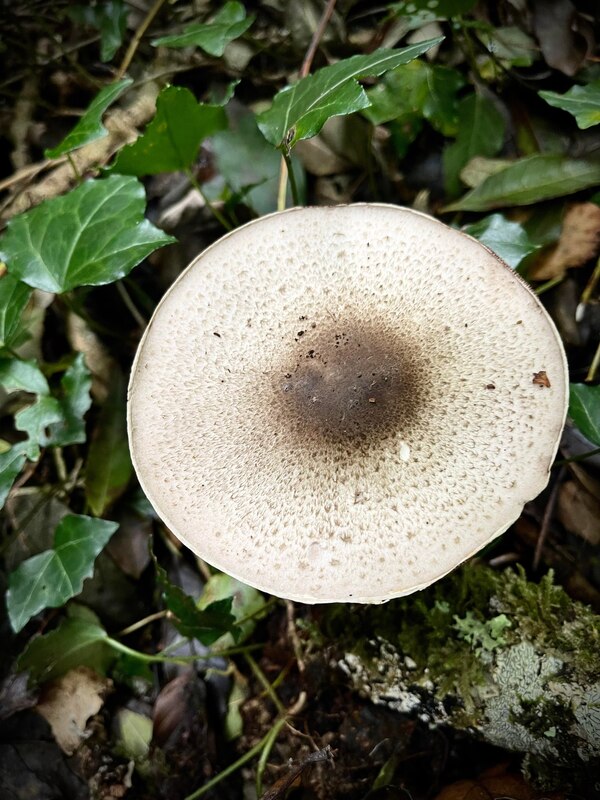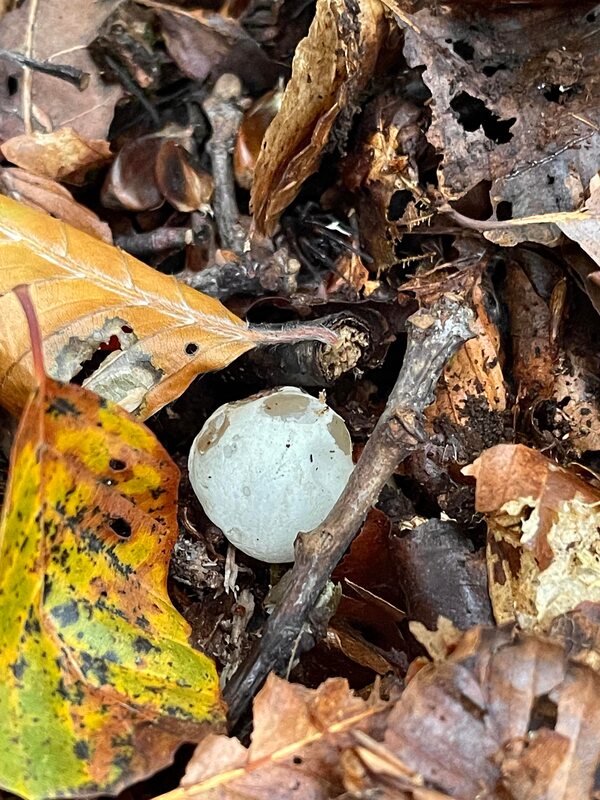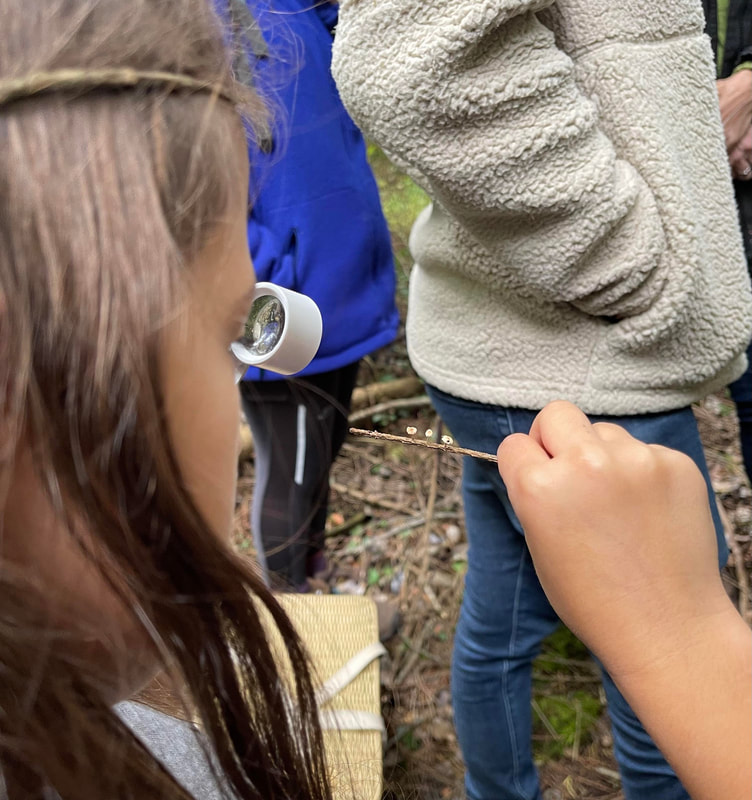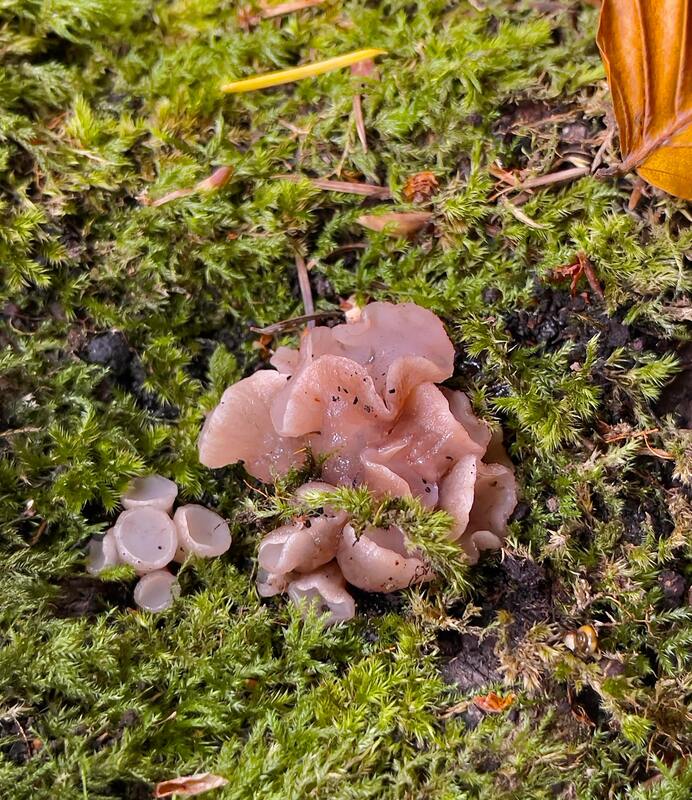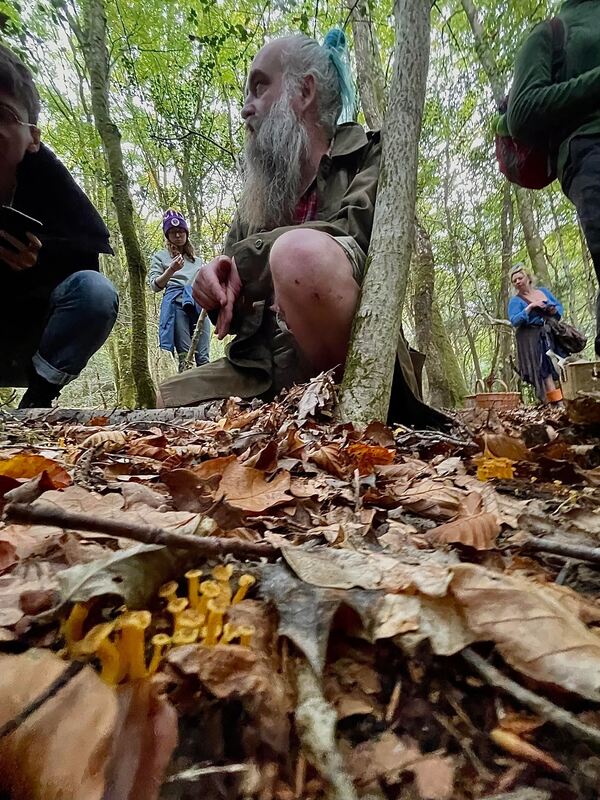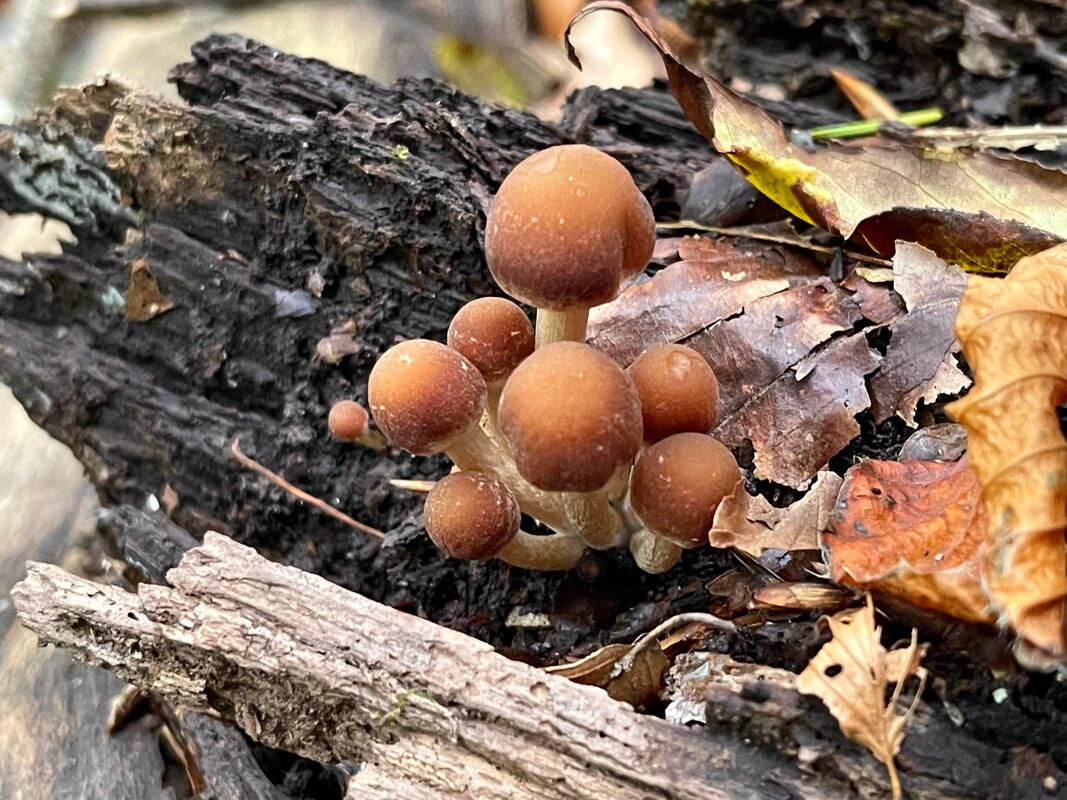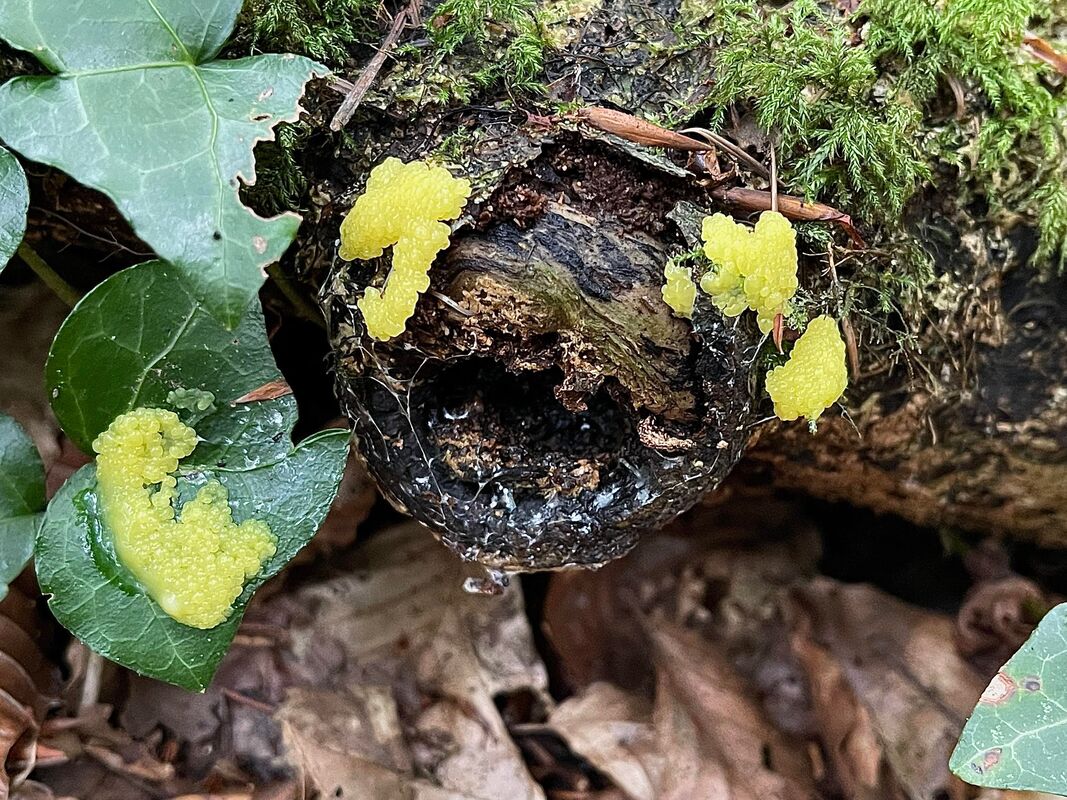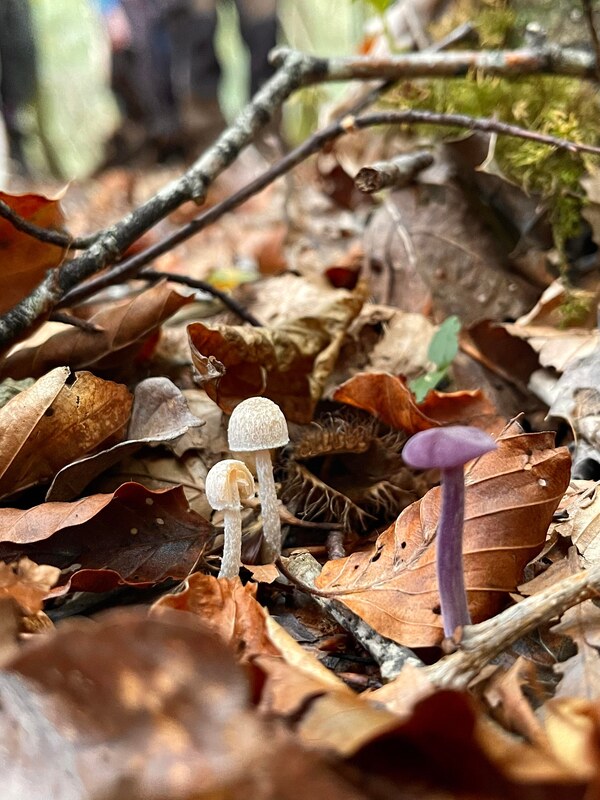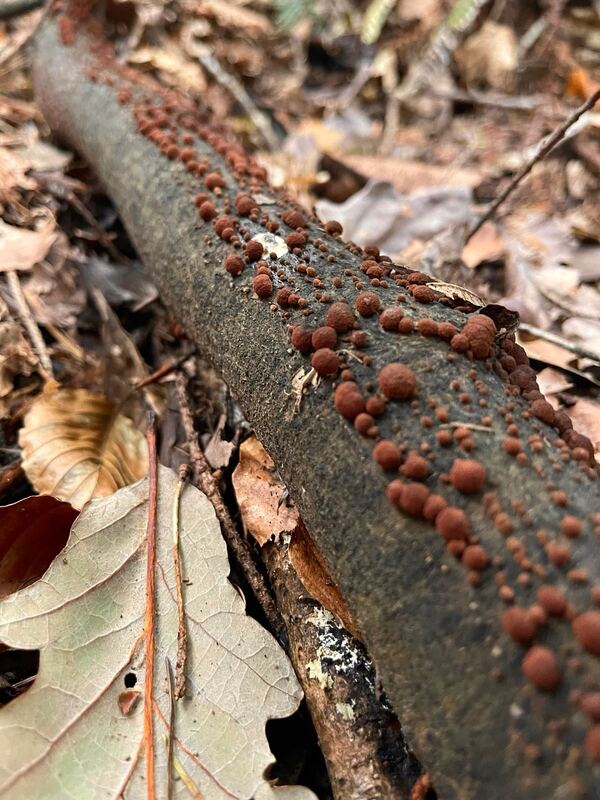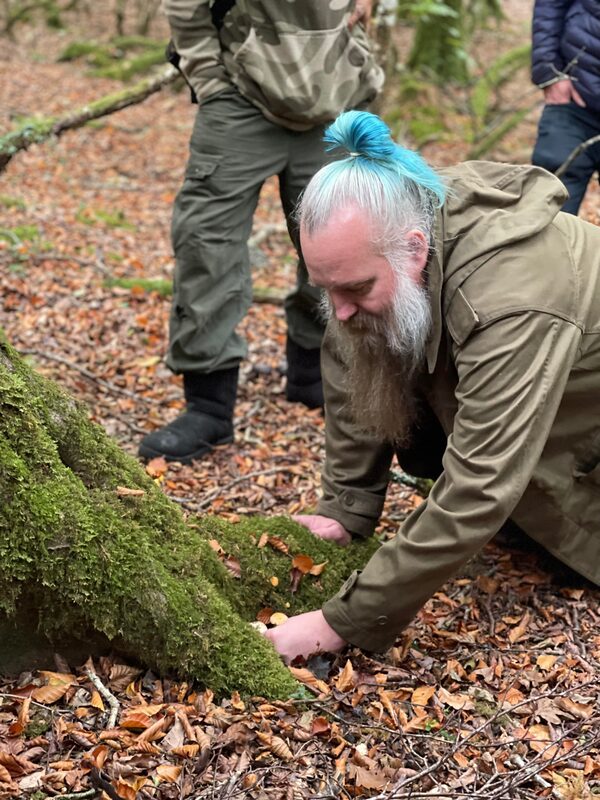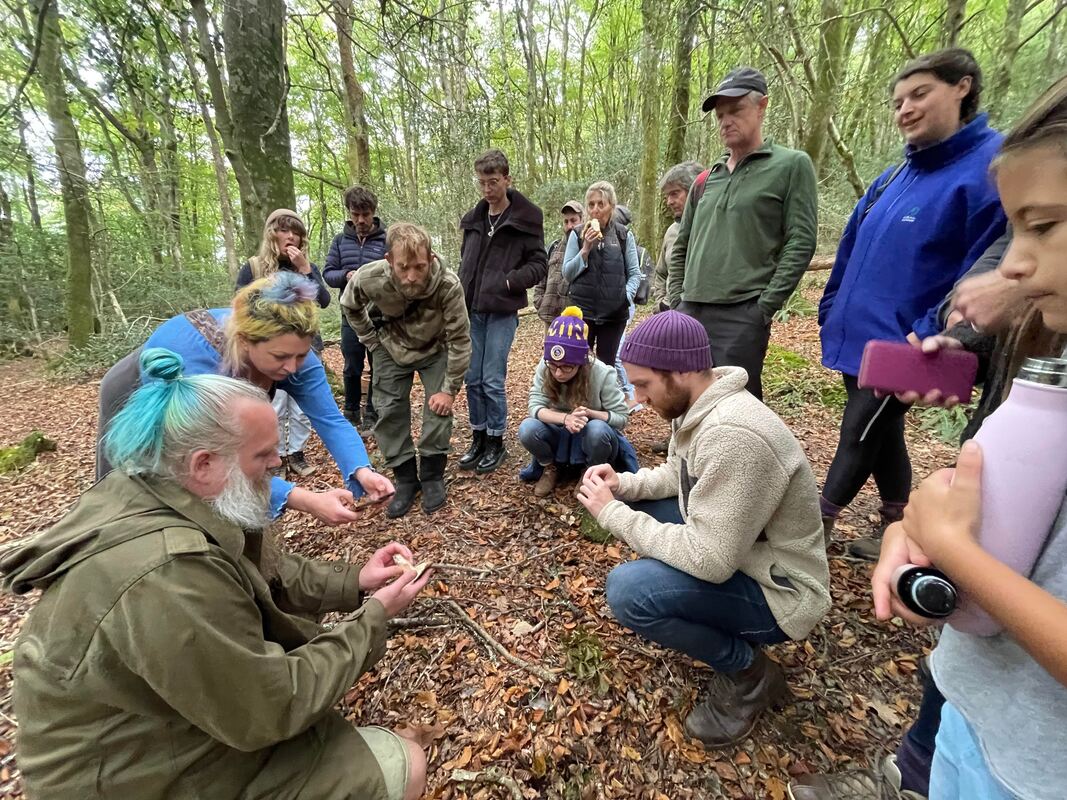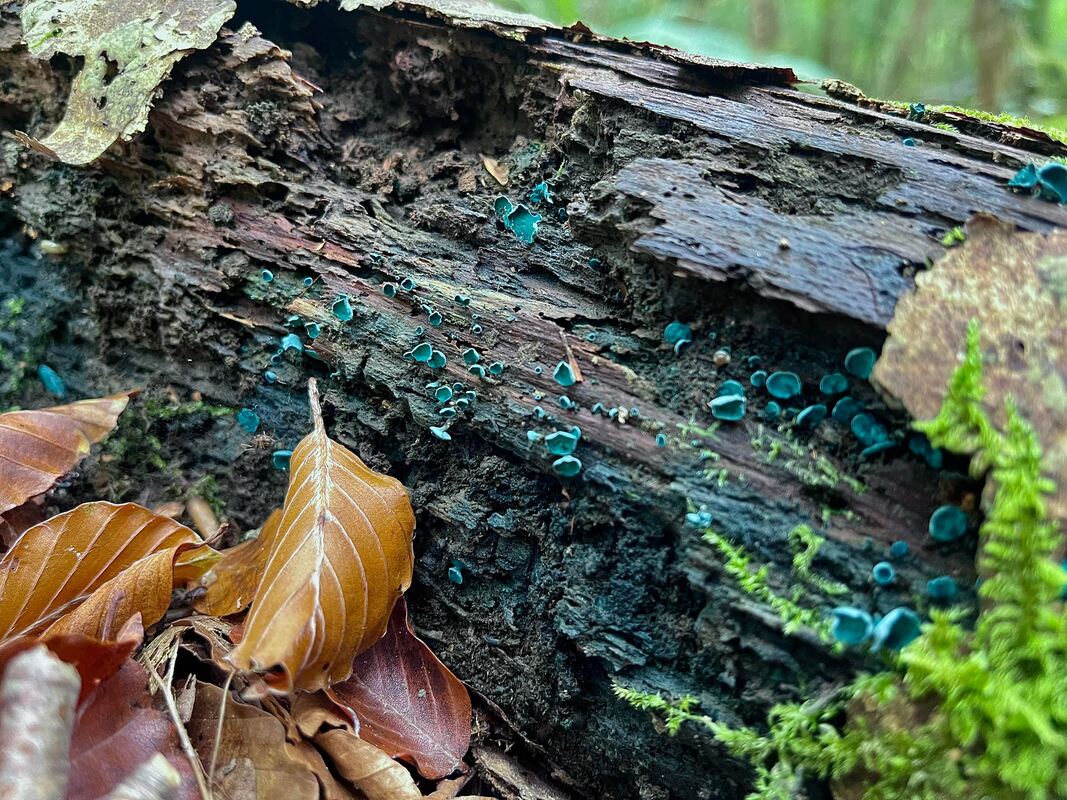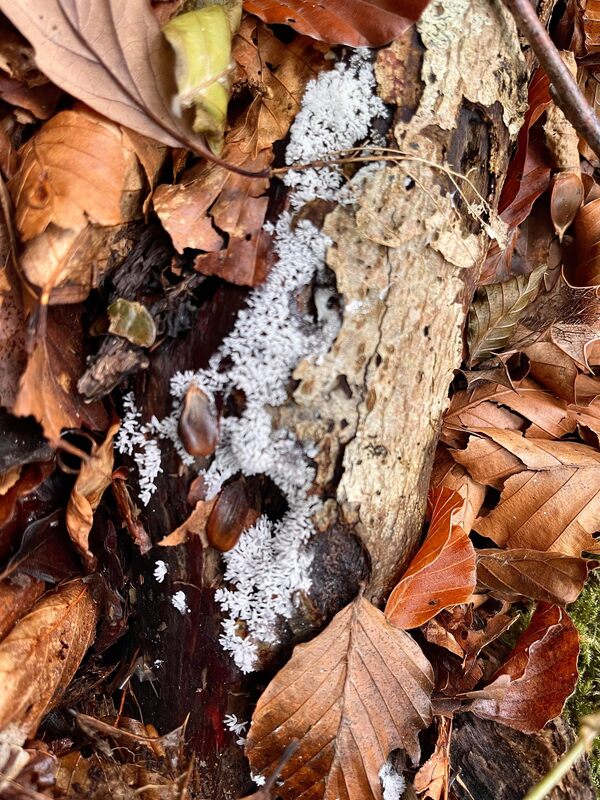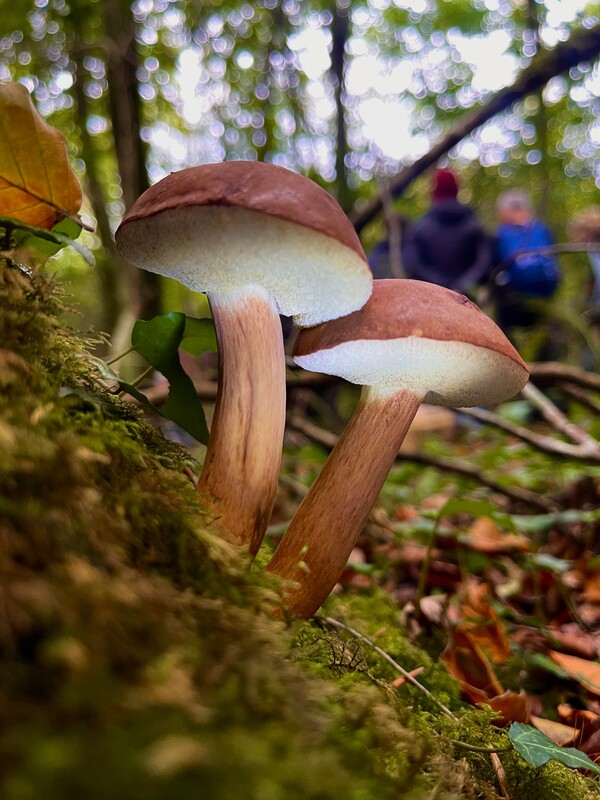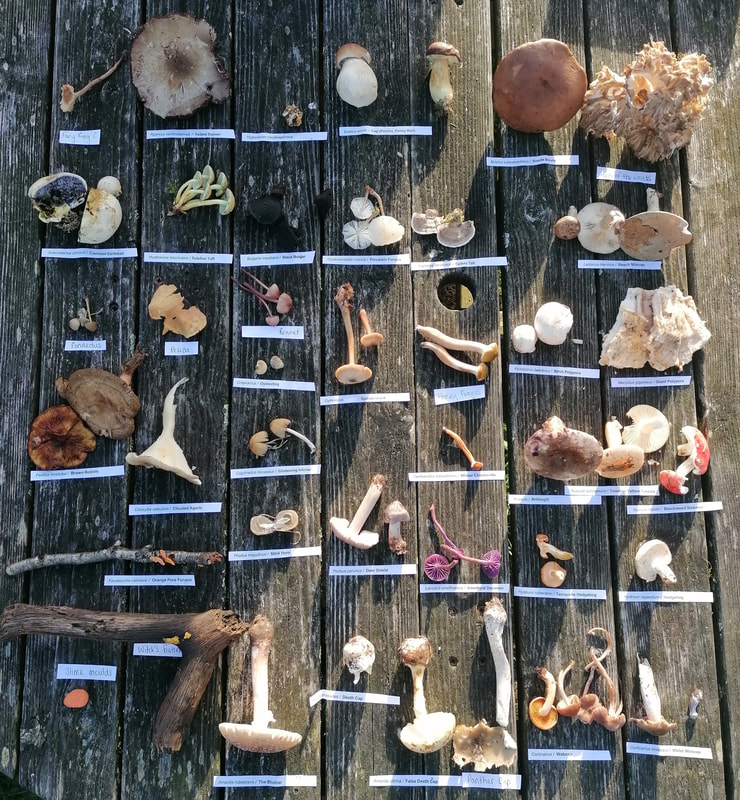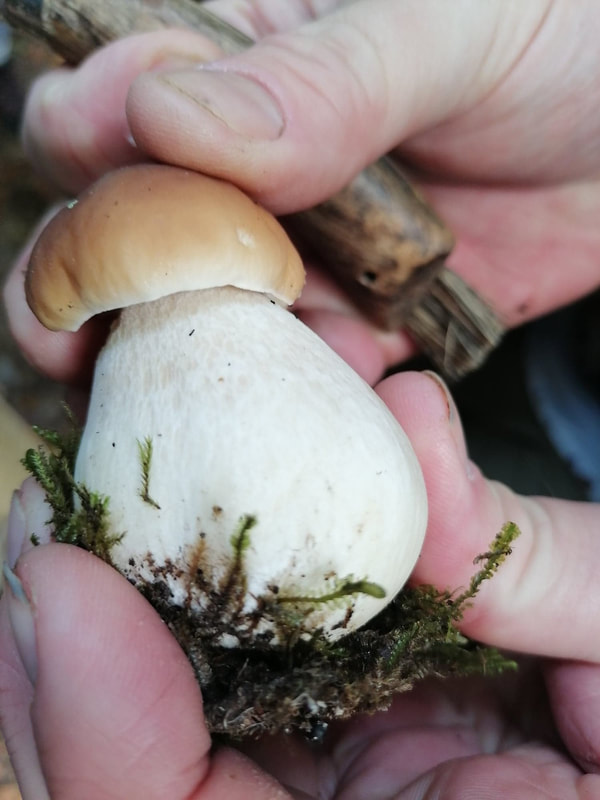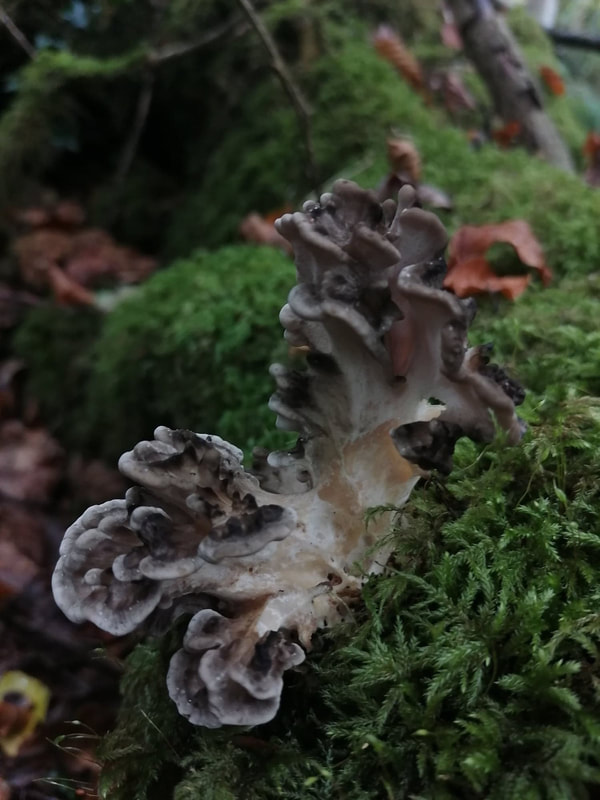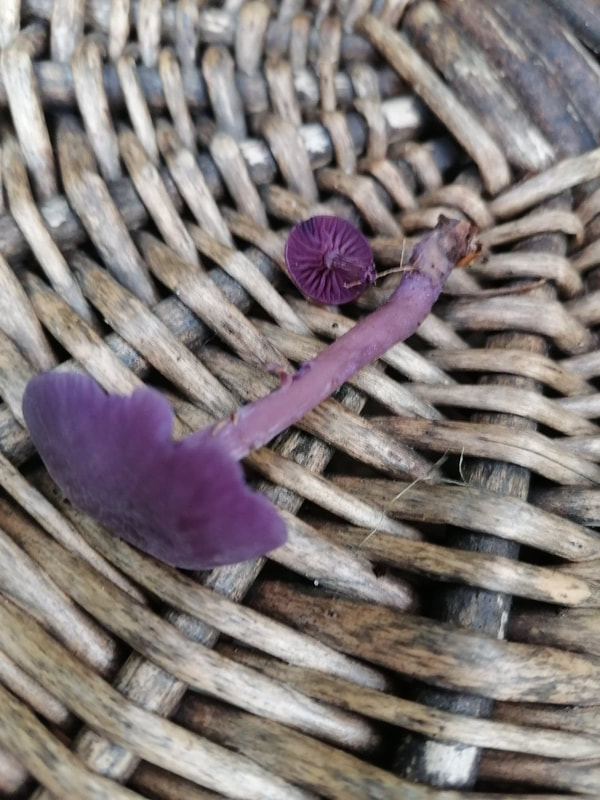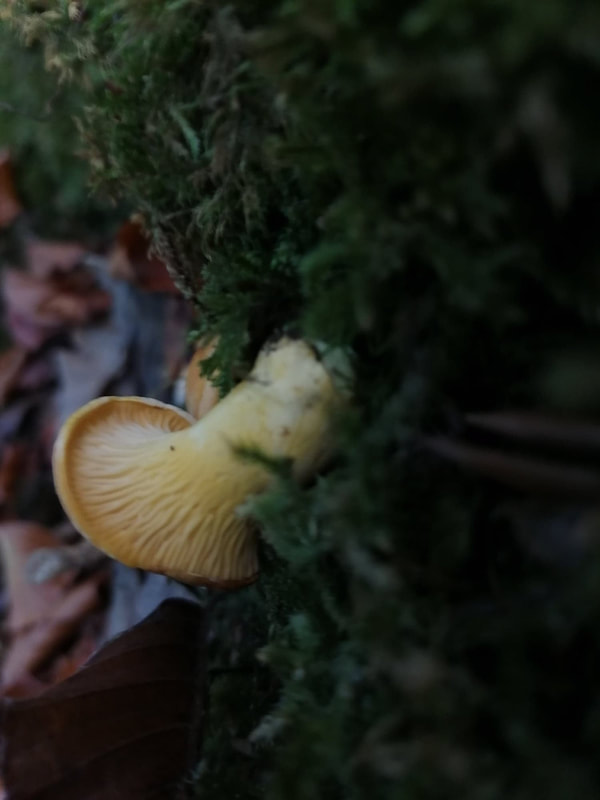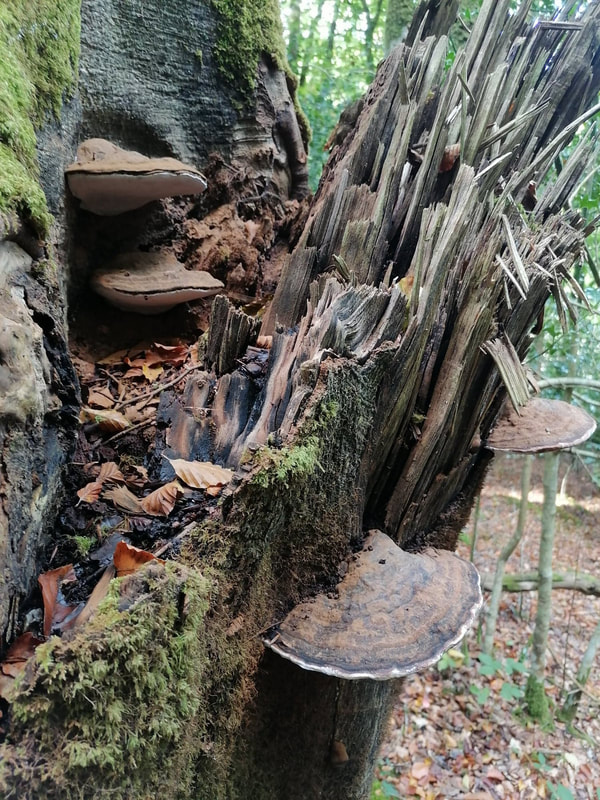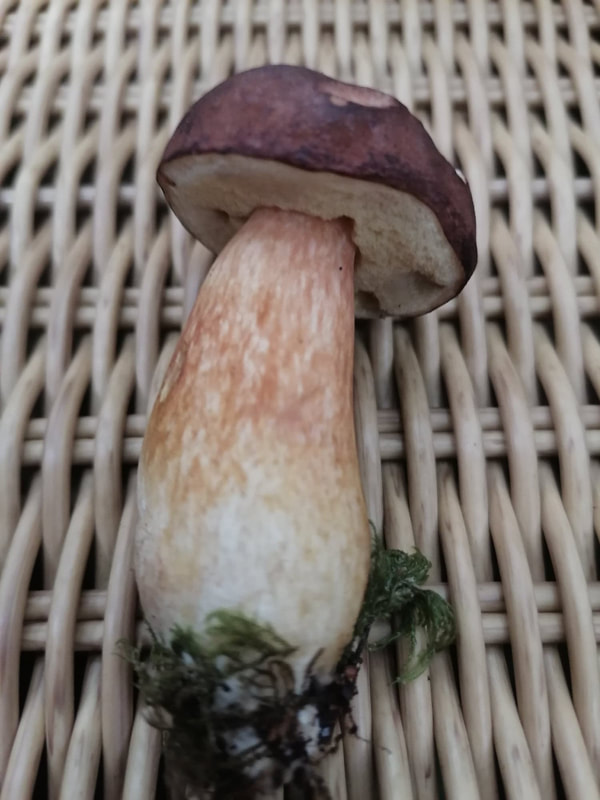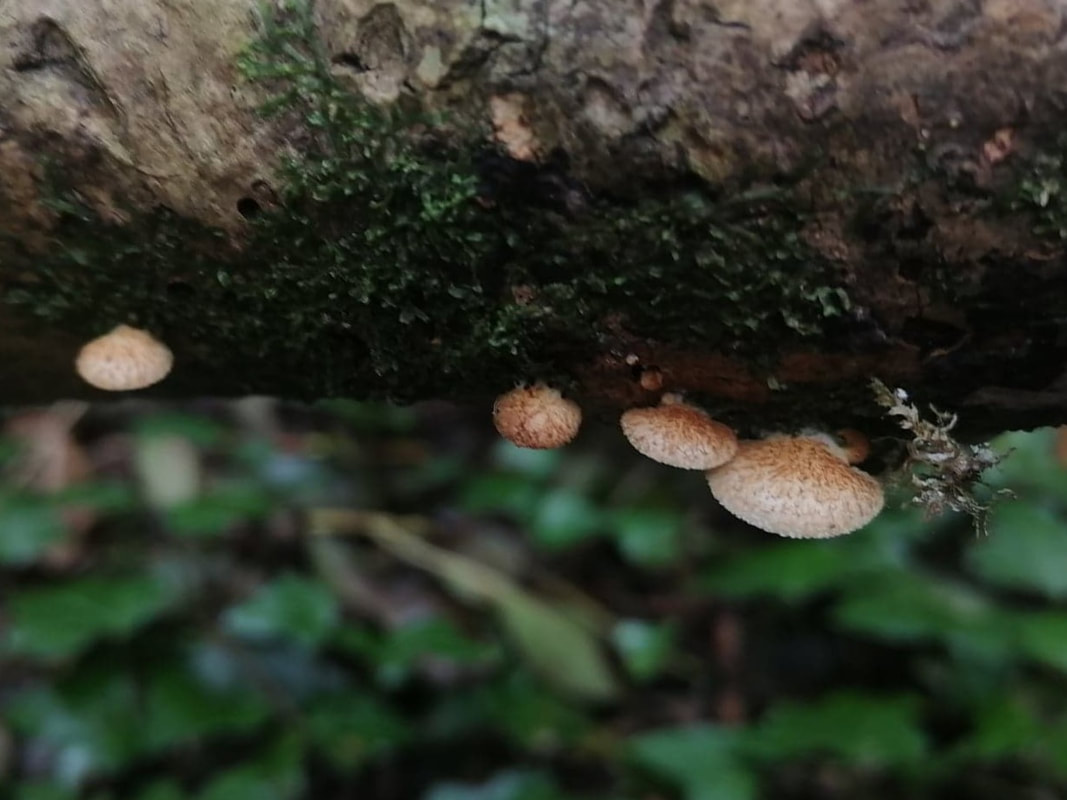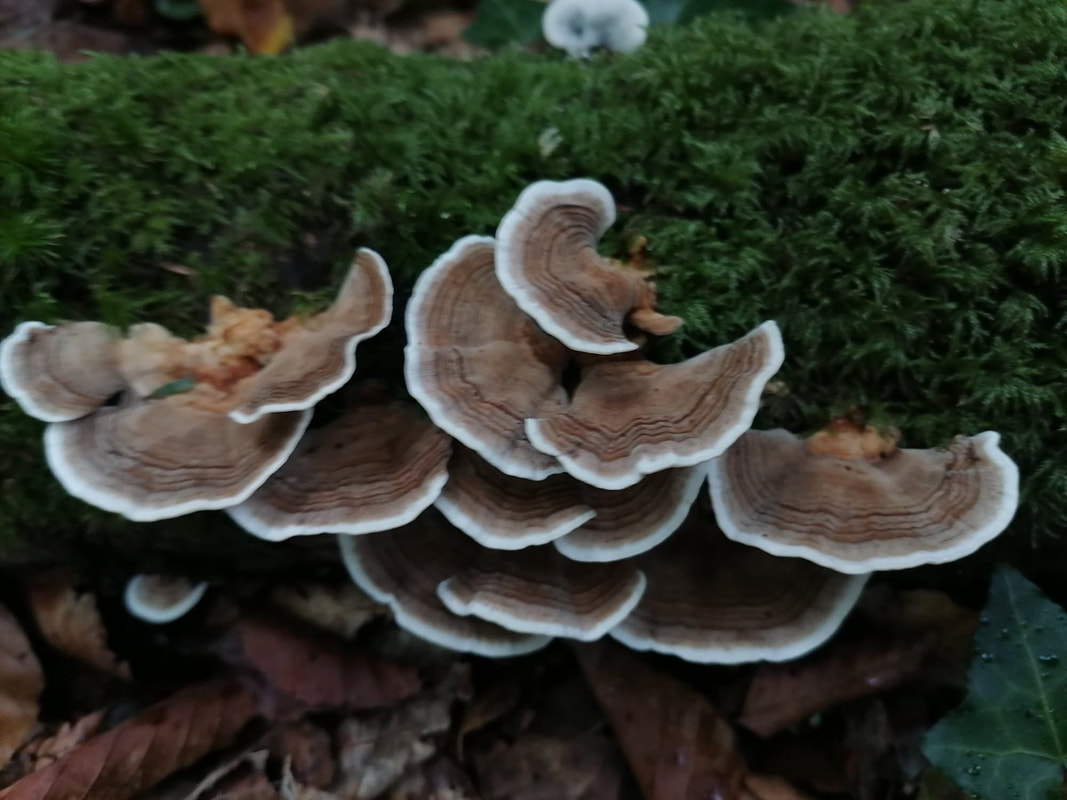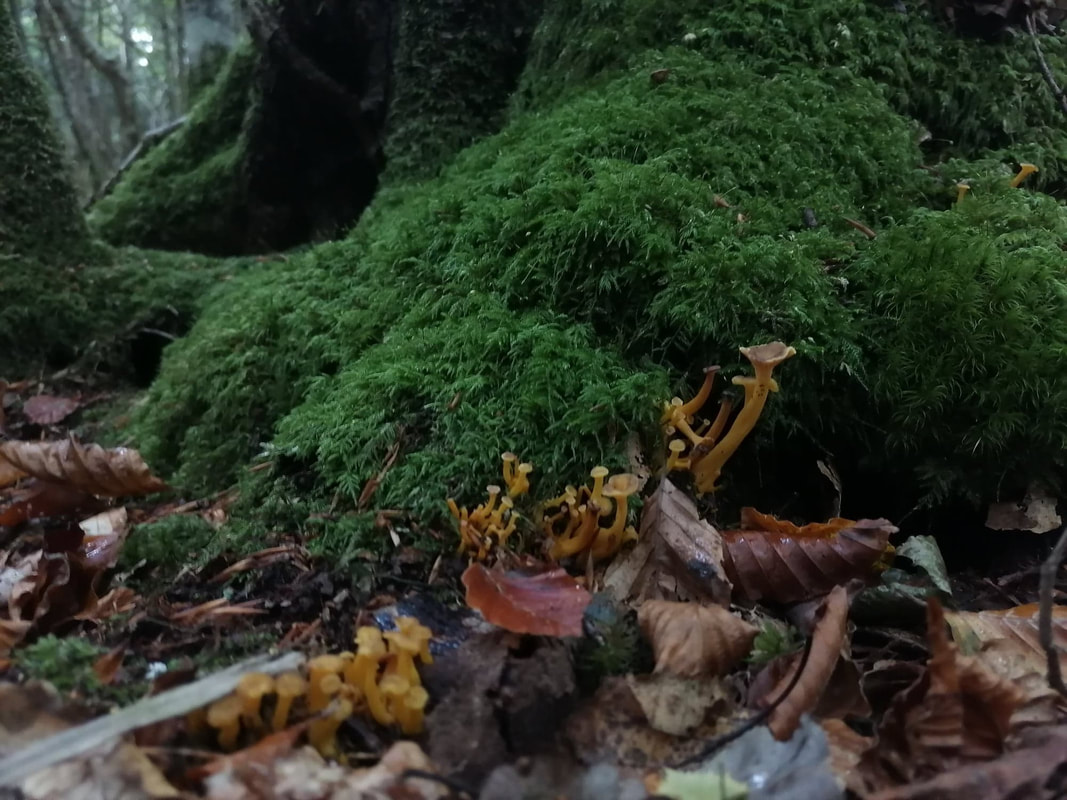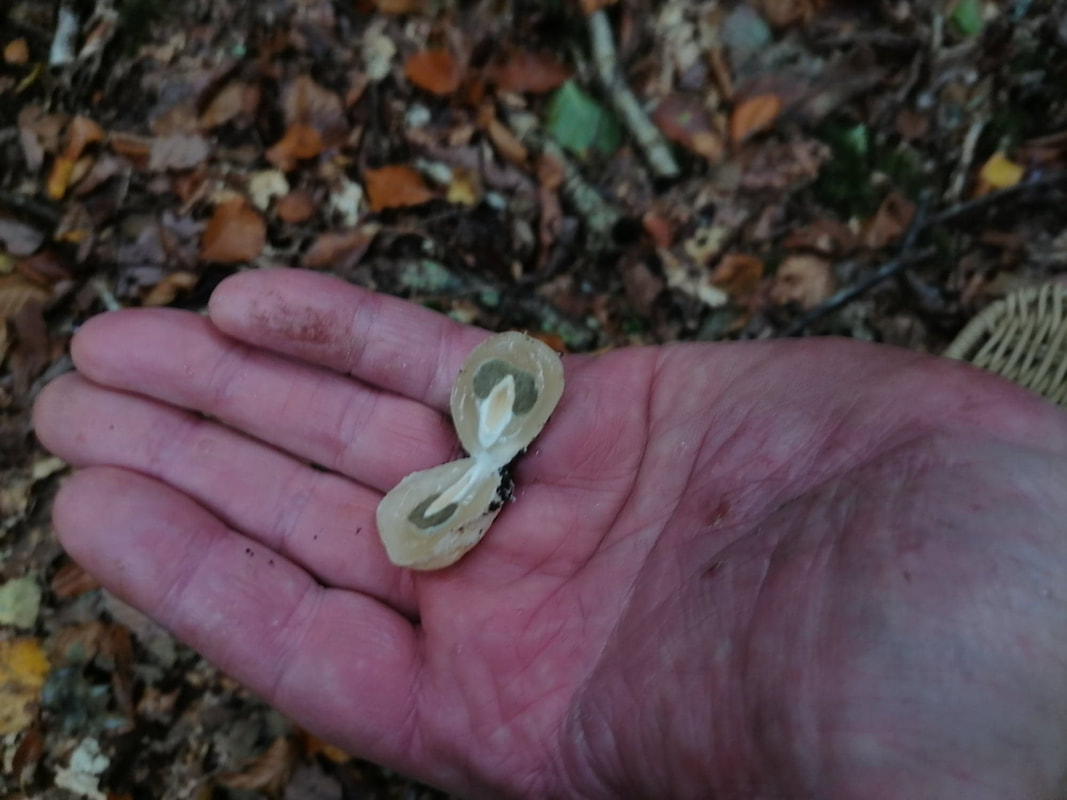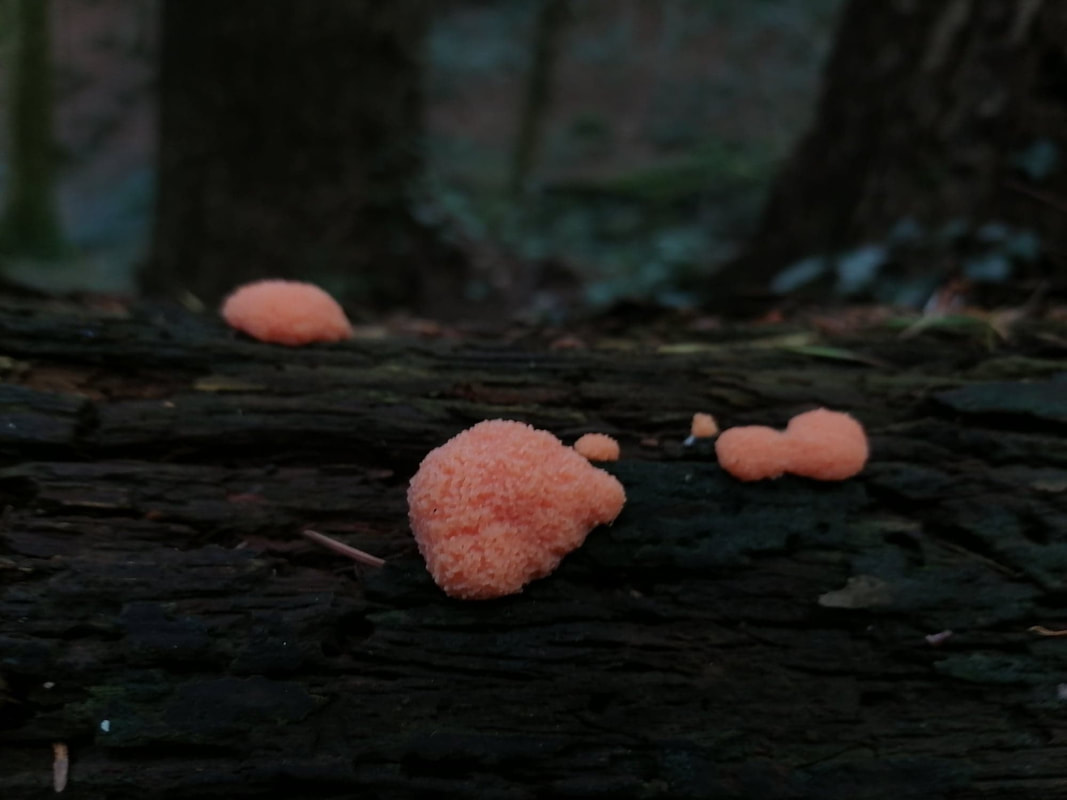|
On Sunday the 23rd we had a glorious ramble around a beautiful woodland near Okehampton. We were anxious about the weather as our previous excursion here was very sodden, but fortunately the sun shone for most of the day, except for a brief shower towards the end. Our guests today consisted mostly of a large group of exuberant friends, whose joviality and friendliness encompassed not only Matt and I but the other guests. I forgot to bear in mind that the van drives slower than the car, so we arrived a little late, but our guests were gracious about the late start. The problem we have with these woods that we are literally tripping over fungi, the sheer quality and diversity is mind blowing, so Matt and I struggle to reign it in and keep things simple. Writing this up is going to be difficult as there were so many interesting or unusual or noteworthy species, so please bear with me! We were able to begin the walk with a stunning false white death cap (Amanita citrana var. Alba). Soon after this this Matt encouraged anyone who was brave enough (and pretty much everyone was!) to spit test the common yellow russula (Russula ochroleuca) which can be spicy or peppery when nibbled raw. Today we found a very peppery one! Much spitting followed this test, and we were happy with our identification. We then found a fascinating jelly fungus which... (ha ha) we were able to identify later as... Witches' butter (Exidia glandulosa) which (ha ha) according to First Nature (first-nature.com) an alternative explanation for its unusual name was that it was believed that throwing this fungus onto a fire would remove a witches curse! Another notable find was a pale bolete which stained blue and begun a discussion about pores and how boletes use these as a spre dispersal method. A few more fungi, and then we found some examples of two highly prized edible mushrooms, winter chanterelles (Craterelleus tubaeformis) with their beautiful yellow stipe (hence the American common name yellow legs) and terracotta hedgehogs (Hydnum rufescens) the key ident of which is the unusual spines so it easily identifiable for even the most novice of forager. As we walked on we discovered a lovely little fluffy white fungi growing on some dead coniferous wood. Matt later identified this as the powderpuff bracket (Postia pytchogaster). We had barely walked 40 meters away from the car park and had already discussed about 20 species! I was keen to press on but Matt found a beautiful large patch of false death caps (Amanita citrana) which led to one of our guests finding the rare sinuous chanterelle (Psuedocraterellus undulatus). Our excitement was nearly uncontainable, my apologies for all the squealing! A lovely long patch of these mushrooms were stress fruiting along the verges of the pathway. We then managed to finally cross the road to explore a different part of the woods, finding a small patch of orange pore fungus (Favolaschia calocera) on the way. Another noteworthy find (at least for me), was the bitter bolete (Tylopilus felleus) as this gave us the opportunity to discuss the most coveted edible mushroom, Cep / Penny bun / Porcini (Boletus edulis), as sadly we found none of these delicious fungi today but Matt was able to stress the importance of double, no triple, no quadruple checking your key identification features before consuming wild mushrooms. We went on to admire a particularly large patch of white club fungus (????) as we entered the coniferous patch of woodland, promoting a discussion about cauliflower fungus (Sparassis crispa), and lo and behold, we realised there was an absolute beast of a cauliflower growing under a pine tree next to us! Cue much excitement, and next to this beauty was a lovely example of a bay bolete (Boletus badius / Imleria badia). Bay boletes featured heavily on the rest of the walk, and Matt shared his tips for novice foraging of boletes, one of which is to stay away from blue staining boletes in general, except with this beauty as the staining is slow and in some instances non-existent (we are aiming to follow this up with a blog post on more tips for foraging boletes for beginners). Fortunately we were able to find enough samples of bay boletes that I think everyone who was interested were able to nibble on some raw and experience the taste to know one of the key features to look for. I know what several people are having for dinner tonight as we found enough for people to keep some for themselves. We then had quite a quiet patch, the fungi had retreated, but we then went exploring into the deepest darkest coniferous woodland, where the floor had a deep covering of moss with wood sorrel absolutely blooming everywhere. I managed to loose both myself and then the baskets briefly as I got caught up in the magic of the woods. One of the group found an absolutely gorgeous greeny yellow mycena which quickly became dubbed "the stunted brummie" in honour of this gentleman forager. Much teasing ensued, to the pleasure of the entire group. Hooray for keen sighted self-depreciating brummies! We also found a surprising amount of blushers (Amanita rubescens), the appearance of this mushroom emerging from it's volva was particularly phallic leading to some anecdotes about stinkhorns (Phallus impudicus), and although none were spotted today we enjoyed a good chuckle about this rude mushroom. One of the group then emerged from the woods clutching a false panthercap (Amanita excelsor var. spissa)asking if we'd covered this mushroom today. Both Matt and I were excited to see this mushroom as it was our first time! And what a beauty it was. Another super exciting discovery was made by one of the guests (honestly I'm not jealous of our guests finding all the interesting fungi!) a small mushroom parasitising on a blackening russula (Russula nigricans). This little beauty was so weird and alien and a true pleasure to see. Apparently common, the silky piggyback (Asterophora parasitica), which is very aptly named, this tiny 'shroom likes to feed on larger decaying fungi, in particular russula, and is a lovely example of why fungi are so important in protecting natures' balance, as this is fungi eating fungi to ensure we don't end up covered in fungi! (I'm not sure how true this is, but please forgive me some artistic licence). This may have been my favourite discovery of the day, huge kudos to the lovely guest who pointed it out to me! It was about then that we realised it was time to head back, so Matt took the group to search for a deathcap (Amanita phalloides) on the way back to the car park whilst I headed straight back to lay out some yummy treats for our guests. Their search was successful, so Matt was able to demonstrate a nibble and spit test on this most deadly, but apparently delicious mushroom. Definitely not one I'm willing to try, no matter how nice it tastes! We finished the walk with tea, bread, cheeses, parasol butter (recipe devised by Matt and will be subject to an upcoming blog post I promise!), home-made cashew nut cheese and a wild mushroom pate featuring both terracotta and common hedgehogs, chanterelles (Cantherellus cibarius), winter chanterelles and bay boletes. Whilst our guests nibbled Matt and I lay out, identified and labelled as many of our samples as we were able to. I would like to make a point of thanking all our guests today, as always our guests were polite, interested and engaged. But, in addition to this today's group, composed as it was of a large number of friends, was particularly fun and likeable. It was easy to share our excitement about fungi with you all, and certainly for me, today was the most fun you can have in the woods with your clothes on! Amanita citrina var alba / White False Death Cap
Amanita citrina / False Death Cap Amanita excelsor var. spissa / False Panther Cap Amanita phalloides / Death Cap Amanita rubescens / The Blusher Armillaria gallica / Bulbous Honey Fungus Ascocoryne sarcoides / Purple Jellydisc Asterophora parasitica / Silky Piggyback Boletus subtomentosus / Suede Bolete Calocera viscosa / Yellow Stagshorn Cantherellus tubaeformis / Winter Chanterelle Clavulina coralloides / Crested Coral Fungus Clavulina rugosa / Wrinkled Club Clitocybe nebularis / Clouded Agaric Clitocybe rivulosa / Fool's Funnel Cortinarius / Webcap with Rosecomb mutation Cortinarius bolaris / Dappeled Webcap Crepidotus / Oysterling Exidia glandulosa / Witches' Butter Exidia nucleata / Crystal Brain Fungus Favolaschia calocera / Orange Pore Fungus Helvella crispa / White Saddle Hydnum rufescens / Terracotta Hedgehog Hypholoma fasciculare / Sulphur Tuft Hypomyces chrysospermus / 'The Bolete Eater' (Bolete mold) Imleria badia / Bay Bolete Laccaria amethystina / Amethyst Deceiver Laccaria laccata / The Deceiver Lactarius blennius / Beech Milkcap Lactarius rufus / Rufous Milkcap Leccinum scabrum / Brown Birch Bolete Leotia lubrica / Jellybaby Fungus Lepiota / Dapperling Mycena Mycena epipterygia / Yellowleg Bonnet Mycena haematopus / (Bleeding) Burgundydrop Bonnet Oudemansiella mucida / Porcelain Fungus Paxillus involutus / Brown Rollrim Peziza / Cup Fungus Postia pytchogaster / Powderpuff Bracket Pseudocraterellus undulatus / Sinuous Chanterelle Russula nigricans / Blackening Brittlegill Russula nobilis / Beechwood Sickener Russula ochroleuca / Common Yellow Russula Scleroderma citrinum / Common Earthball Sparassis crispa / Cauliflower Syzygites megalocarpus / a mycoparasite Trametes versicolor / Turkey Tail Tricholoma terreum / Grey Knight Tricholoma ustale / Burnt Knight Tylopilus felleus / Bitter Bolete Xerocomellus cisalpinus / Bluefoot Bolete Xylaria hypoxylon / Candlesnuff Fungus
0 Comments
51 species: Armillaria mellea / Honey Fungus
Leotia lubrica / Jellybaby Fungus Amanita citrina var alba / White False Death Cap Amanita citrina / False Death Cap Amanita rubescens / The Blusher Boletus edulis / Cep (Porcini, Penny Bun) Bulgaria inquinans / Black Bulgar Cantharellus amethysteus / Amethyst Chanterelle Cantharellus cibarius / Chanterelle Cantherellus tubaeformis / Winter Chanterelle Chlorociboria aeruginascens / Green Elfcup Clavulina coralloides / Crested Coral Fungus Clavulinopsis Helvola / Yellow Club Fungus Clitocybe nebularis / Clouded Agaric Cortinarius / Webcap Cortinarius torvus / Stocking Webcap Crepidotus / Oysterling Exidia nucleata / Crystal Brain Fungus Favolaschia calocera / Orange Pore Fungus Ganoderma applanatum / Artist’s Conk Helvella elastica / Elastic Saddle Hydnum repandum / Hedgehog Hydnum rufescens / Terracotta Hedgehog (some with Rosecomb mutation) Hypholoma fasciculare / Sulphur Tuft Hypoxylon fragiforme / Beech Bark Spot Imleria badia / Bay Bolete Kuehneromyces mutabilis / Sheathed Woodtuft Laccaria amethystina / Amethyst Deceiver Laccaria laccata / The Deceiver Lactarius blennius / Beech Milkcap Lactarius pubescens / Bearded Milkcap Lactarius quietus / Oakbug Milkcap Leccinum scabrum / Brown Birch Bolete Lycoperdon pyriforme / Stump Puffball Marasmius hudsonii / Holly Parachute Mycena Mycena haematopus / Burgundydrop Bonnet Neobulgaria pura / Beech Jellydisc Oudemansiella mucida / Porcelain Fungus Peziza / Cup Fungus Pseudocraterellus undulatus / Sinuous Chanterelle Russula cyanoxantha / Charcoal Burner Russula nigricans / Blackening Brittlegill Russula nobilis / Beechwood Sickener Russula ochroleuca / Common Yellow Russula Scleroderma citrinum / Common Earthball Skeletocutis (nivea) / White Crust Fungus Sparassis crispa / Cauliflower Trametes versicolor / Turkey Tail Tricholoma ustale / Burnt Knight Xylaria hypoxylon / Candlesnuff Fungu Here is a list of the 44 species we found, not all are laid out above. Armillaria mellea / Honey Fungus
Agaricus xanthodermus / Yellow Stainer Amanita citrina var alba / White False Death Cap Ascocoryne sarcoides / Purple Jellydisc Boletus edulis / Cep (Porcini, Penny Bun) Bulgaria inquinans / Black Bulgar Cantharellus amethysteus / Amethyst Chanterelle Cantharellus cibarius / Chanterelle Cantherellus tubaeformis / Winter Chanterelle Chlorociboria aeruginascens / Green Elfcup Clavulinopsis Helvola / Yellow Club Fungus Cortinarius / Webcap Cortinarius torvus / Stocking Webcap Crepidotus / Oysterling Fistulina hepatica / Beefsteak Ganoderma applanatum / Artist’s Conk Gymnopus / Spindleshank Hydnum rufescens / Terracotta Hedgehog Hypholoma fasciculare / Sulphur Tuft Imleria badia / Bay Bolete Laccaria amethystina / Amethyst Deceiver Lactarius blennius / Beech Milkcap Lactarius quietus / Oakbug Milkcap Lycoperdon pyriforme / Stump Puffball Mutinus caninus / Dog Stinkhorn Mycena rosea / Rosy Bonnet Mycena haematopus / Burgundydrop Bonnet Neobulgaria pura / Beech Jellydisc Oudemansiella mucida / Porcelain Fungus Paxillus involutus / Brown Rollrim Peziza / Cup Fungus Piptoporus betulinus / Birch Polypore Pseudocraterellus undulatus / Sinuous Chanterelle Russula cyanoxantha / Charcoal Burner Russula nigricans / Blackening Brittlegill Russula nobilis / Beechwood Sickener Russula ochroleuca / Common Yellow Russula Russula versicolor / Variable Brittlegill Scleroderma citrinum / Common Earthball Skeletocutis (nivea) / White Crust Fungus Sparassis crispa / Cauliflower Tricholoma terreum / Grey Knight Tricholoma ustale / Burnt Knight Xylaria hypoxylon / Candlesnuff Fungus The enthusiasm from these two fungi fanatics can't help but be contagious! Their excitement bounces from one to the other and back again. It didn't take long for the group to enjoy listening out for the squeals (and snorts) of excitement as new things were discovered to show everyone. The genuine delight they find in the natural world is captivating. We smashed our personal challenge of 50 and found 54 different species of fungi! Armillaria mellea / Honey Fungus Agaricus xanthodermus / Yellow Stainer Amanita citrina / False Death Cap Amanita citrina var alba / White False Death Cap * Amanita phalloides / Death Cap Bulgaria inquinans / Black Bulgar Cantharellus cibarius / Chanterelle Cantherellus tubaeformis / Winter Chanterelle Chlorociboria aeruginascens / Green Elfcup * Coprinellus micaceus / Glistening Inkcap * Cortinarius / Webcap Cortinarius violaceus / Violet Webcap Crepidotus calolpis / Scaly Oysterling Favolaschia calocera / Orange Pore Fungus * Fistulina hepatica / Beefsteak Ganoderma applanatum / Artist’s Conk Grifola frondosa / Hen of the Woods * Gymnopilus junonius / Spectacular Rustgill (Laughing Gym) Gymnopus / Spindleshank Hydnum repandum / Hedgehog Hydnum rufescens / Terracotta Hedgehog Hypholoma fasciculare / Sulphur Tuft * Hypomyces chrysospermus / 'The Bolete Eater' (Bolete mold) * Imleria badia / Bay Bolete Laccaria amethystina / Amethyst Deceiver Laccaria laccata / The Deceiver Lactarius blennius / Beech Milkcap Lactarius pubescens / Bearded Milkcap Lactarius quietus / Oakbug Milkcap * Leotia lubrica / Jellybaby Fungus Lepiota / Dapperling Marasmius oreades / Fairy Ring Champignon Meripilus giganteus / Giant Polypore Mycena Mycena rosea / Rosy Bonnet Mycena haematopus / Burgundydrop Bonnet Oudemansiella mucida / Porcelain Fungus * Paxillus involutus / Brown Rollrim Peziza / Cup Fungus * Phallus impudicus / Stink Horn (egg) Pluteus cervinus / Deer Shield Russula atropurpurea / Blackish Purple Russula Russula cyanoxantha / Charcoal Burner Russula nigricans / Blackening Brittlegill Russula nobilis / Beechwood Sickener Russula ochroleuca / Common Yellow Russula Scleroderma citrinum / Common Earthball * Skeletocutis (nivea) / White Crust Fungus Sparassis crispa / Cauliflower Trametes versicolor / Turkey Tail Tricholoma virgatum / Ashen Knight Tubifera ferruginosa / Rasberry Slime Mold Xerocomellus chrysenteron / Red Cracked Bolete Xylaria hypoxylon / Candlesnuff Fungus * * not pictured below
48 species of fungi and 1 slime mould (*the 6 not pictured on the table lay out) Agaricus xanthodermus / Yellow Stainer Amanita citrina / False Death Cap Amanita pantherina / Panther Cap Amanita phalloides / Death Cap (volva only) Amanita rubescens / The Blusher Armillaria mellea / Honey Fungus Boletus edulis / Cep (Porcini, Penny Bun) Boletus subtomentosus / Suede Bolete Bulgaria inquinans / Black Bulgar Cantharellus cibarius / Chanterelle * Cantherellus tubaeformis / Winter Chanterelle Clitocybe nebularis / Clouded Agaric Coprinellus micaceus / Glistening Inkcap Cortinarius / Webcap Cortinarius violaceus / Violet Webcap Crepidotus calolpis / Scaly Oysterling Crepidotus variabilis / Variable Oysterling Favolaschia calocera / Orange Pore Fungus Ganoderma applanatum / Artist’s Conk * Grifola frondosa / Hen of the Woods Gymnopus / Spindleshank Hydnum repandum / Hedgehog Hydnum rufescens / Terracotta Hedgehog Hypholoma fasciculare / Sulphur Tuft Hypomyces chrysospermus / 'The Bolete Eater' (Bolete mold) Imleria badia / Bay Bolete Laccaria amethystina / Amethyst Deceiver Lactarius blennius / Beech Milkcap Leotia lubrica / Jellybaby Fungus * Marasmius oreades / Fairy Ring Champignon Meripilus giganteus / Giant Polypore Mycena haematopus / Burgundydrop Bonnet Oudemansiella mucida / Porcelain Fungus Panaeolus / Mottlegill Paxillus involutus / Brown Rollrim Peziza / Cup Fungus Phallus impudicus / Stink Horn (egg) Piptoporus betulinus / Birch Polypore Pluteus cervinus / Deer Shield Russula cyanoxantha / Charcoal Burner * Russula nigricans / Blackening Brittlegill Russula nobilis / Beechwood Sickener Russula ochroleuca / Common Yellow Russula Scleroderma citrinum / Common Earthball Skeletocutis (nivea) / White Crust Fungus * Sparassis crispa / Cauliflower * Trametes versicolor / Turkey Tail Tremella mesenterica / Yellow Brain Fungus (Witch's Butter) Tubifera ferruginosa / Rasberry Slime Mold |
